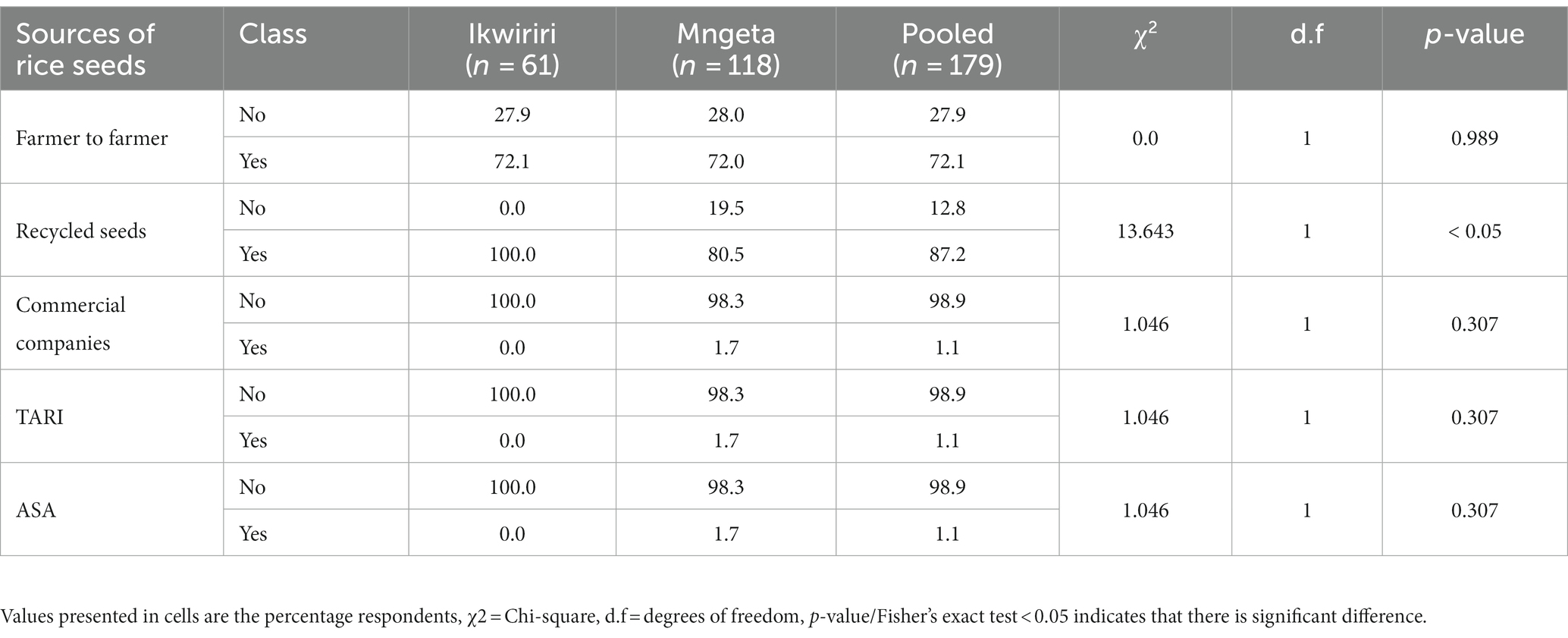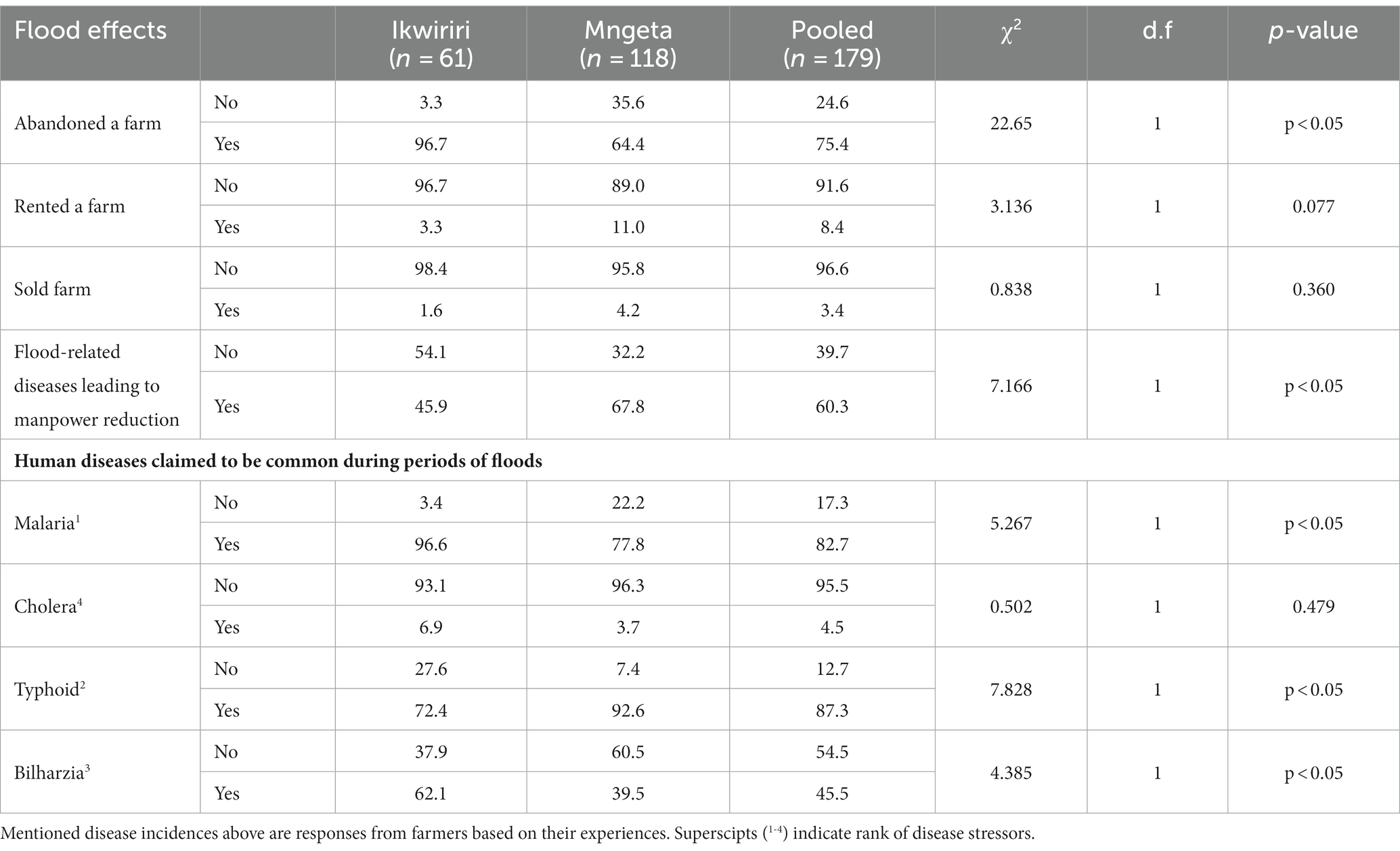Floods stress in lowland rice production: experiences of rice farmers in Kilombero and Lower-Rufiji floodplains, Tanzania
- 1Department of Soil and Geological Sciences, College of Agriculture, Sokoine University of Agriculture, Morogoro, Tanzania
- 2Department of Crop Science and Horticulture, College of Agriculture, Sokoine University of Agriculture, Morogoro, Tanzania
- 3Tanzania Agricultural Research Institute (TARI), Dodoma, Tanzania
- 4Department of Biology, University of Copenhagen, Copenhagen, Denmark
The resilience of rice production to floods is a crucial aspect of agricultural development in flood-prone regions. However, little is known about the farming practices and challenges of rice farmers in two river basins in Tanzania: Lower-Rufiji and Kilombero, where rice is the main crop grown. This study aimed to investigate the experiences of farmers in these two rice-growing floodplains regarding the impact of floods on lowland rice production and farmer livelihoods, and the strategies they use to cope with floods. The study used a mixed-methods approach that involved household surveys, key informant interviews, and transect walks to collect data from 180 rice farmers and 14 experts and community leaders. The data analysis revealed that floods were the dominant stressor affecting rice production, occurring mostly during the long rainy season and experienced by all farmers in both locations. Floods not only caused significant crop losses, especially in Lower-Rufiji where farmers reported losing between 75 and 100% of their yield in cases of extreme floods, but also made it difficult to establish and manage crops, leading to crop land abandonment. Floods also affected the livelihoods of rice farmers by forcing them to abandon, rent, or sell their farms. Coexistence of floods with other biotic and abiotic stresses such as crop diseases and droughts also limited the use of short maturing high yielding rice varieties. Farmers have adopted on-farm strategies such as adjusting planting schedules, using different varieties of rice, changing to other crops or activities after the floods to cope with floods, but these practices face numerous challenges. The study recommends the development of early warning systems, breeding for flood-tolerant rice varieties, introgression of tolerance traits to multiple stresses and improving crop establishment methods to enhance the resilience of farmers to floods and other extreme climate events.
1 Introduction
Rice fields in floodplains are often subject to natural flooding, which can result in significant crop losses, particularly in the context of climate change (Mackill et al., 2010). Floods can also be artificially induced for irrigation purposes, which can help control weeds and other pests (Ismail et al., 2012). However, uncontrolled floods can cause two types of abiotic stress in rice: anaerobic germination and vegetative submergence (Das et al., 2009; Bailey-Serres et al., 2010). Anaerobic germination occurs when rice seeds are sown directly into flooded soil, limiting the availability of oxygen for germination and seedling growth. Vegetative submergence occurs when established rice plants are submerged by flash floods impairing gas exchange and photosynthesis, leading to reduced growth and productivity (Singh et al., 2011). As a result, understanding the mechanisms and genetic factors that contribute to flood tolerance in rice is essential for developing resilient varieties that can withstand different flooding scenarios.
Breeding rice varieties that can withstand flood-related stresses has been a remarkable achievement of the global effort to manage flooding challenges. These varieties can cope with different kinds of flooding stresses, such as vegetative submergence and anaerobic germination. They have been developed using molecular methods that transferred key genes from traditional varieties to modern high-yielding ones. One of these genes is SUB1, which enhances submergence tolerance by reducing excessive growth and saving energy under water (Panda and Barik, 2021; Raghu et al., 2022). Another gene is AG1 and AG2, which confers anaerobic germination and coleoptile extension in flooded soils. These genes have been introgressed into several rice varieties, such as Swarna Sub1, Ciherang SUB1, and IR64-Pup1-AG1, which have performed well and been adopted in flood-affected areas of Asia (Kuroha and Ashikari, 2020; Shin et al., 2020). For example, Swarna SUB1 has improved yield by up to 19% for small-scale farmers in East India (Raghu et al., 2022). However, farmers in many parts of Africa still do not have access to seeds tolerant to flood-related stresses and information on flood-tolerant rice varieties. Therefore, there is a need to improve seed systems, extension services, awareness campaigns, and policies to support the distribution and scaling up of these technologies in Africa. Identifying flood-prone hotspots and vulnerable communities is inevitable step toward informed dissemination of rice varieties tolerant to flood-related stress.
In Africa, Inland Valleys makes Africa’s largest rice growing ecosystem, with approximately 130 million hectares suitable for rice farming. Aside from river floodplains, inland-valleys encompasses seasonally flooded wetlands of valley bottoms and hydromorphic fringes (Rodenburg et al., 2014). According to Harlan and Stemler (1976), the major countries in Africa with majority of inland valleys under lowland rice production are Nigeria, Madagascar, and Tanzania. Generally, river valleys in Africa account for significant portions of flood-prone rice growing areas. As river floodplains are prone to flooding, submergence is one of the most frequent and important abiotic stresses.
About 71% of rice grown in Tanzania is cultivated in floodplains and inland valleys that are susceptible to flooding, with these areas relying solely on rainfall (Gabiri et al., 2018). Among many abiotic stresses, vegetative submergence and anaerobic germination are among the least studied stresses in rice in floodplains of Tanzania. Several studies have explained factors associated with floods in river basins of Tanzania, among them, basin geomorphology, rainfall intensities and soil hydrological properties have been explored. Michael et al. (2023), revealed interannual variability in flooded areas in Kilombero and Lower-Rufiji, hance giving evidence of flood dynamics in to river basins. Studies by Kwesiga et al. (2019), further investigated effects of hydrological positions on rice yield gap in Kilombero valley. The study realized rice yield variability in centre positions of the river, a zone prone to submergence. Such gap was attributed to submergence stress especially at the younger stages of rice crop growth.
Out of what is known about abiotic stresses emerging from floods in river valleys and floodplains, little is known about the vulnerability of rice farmers to floods scenarios in river basins of Tanzania. Again, for sustainability of rice farming under flood risk environment of flood plains, it is inevitable to understand how rice farmers experience hydrodynamics and uncertain growing conditions of the river floodplains (Höllermann et al., 2021).
Aiming to fill the existing knowledge gap, our research concentrated on examining farmers’ perceptions of flood events, their impacts, and other associated stresses. Our research focuses on the Kilombero and Lower-Rufiji floodplains, each one having unique characteristics and challenges, including distinct climatic and geographical conditions, flood occurrence, and farming practices. For instance, Lower Rufiji is a downstream river valley geographically located in Coastal zone and is connected to multiple upstream sub-basins leading extensive floods compared to upstream Kilombero basin (Michael et al., 2023). We hypothesize that the geographical differences between Kilombero and Lower-Rufiji influence flood occurrences, which in turn affect the vulnerability and adaptation of the surrounding communities. By tailoring our research design to these areas, we aim to gain a detailed understanding of local contexts and ensure that the strategies we propose are suited to each region’s specific needs. We also delved into how rice farmers handle challenges brought about by extreme climate events leading to flooding incidents. The findings from this study will assist in formulating strategies, including breeding strategies, to boost the resilience of rice farmers to flood-related stresses.
2 Methodology
2.1 Study area
The Rufiji basin is comprised on four sub-basins namely, Kilombero, Lower-Rufiji, Luwengu, and Ruaha sub-basins. This study is focused in two major rice growing sub-basins of the Rufiji basin: Kilombero and Lower-Rufiji. In Kilombero, the study was conducted in Mngeta division while in Lower-Rufiji, the study was conducted in Ikwiriri ward (Figure 1). The study areas were purposively following preliminary survey and Sentinel-1 satellite-based spatial–temporal mapping of flood occurrence and extent (Michael et al., 2023). The preliminary survey identified areas affected by floods and indicated that over 87% of farmers in the study areas are rice growers. Rice farming and fishing are the dominant economic activities in the selected study areas and seasonal floods are known to be one of the common stresses around the areas.
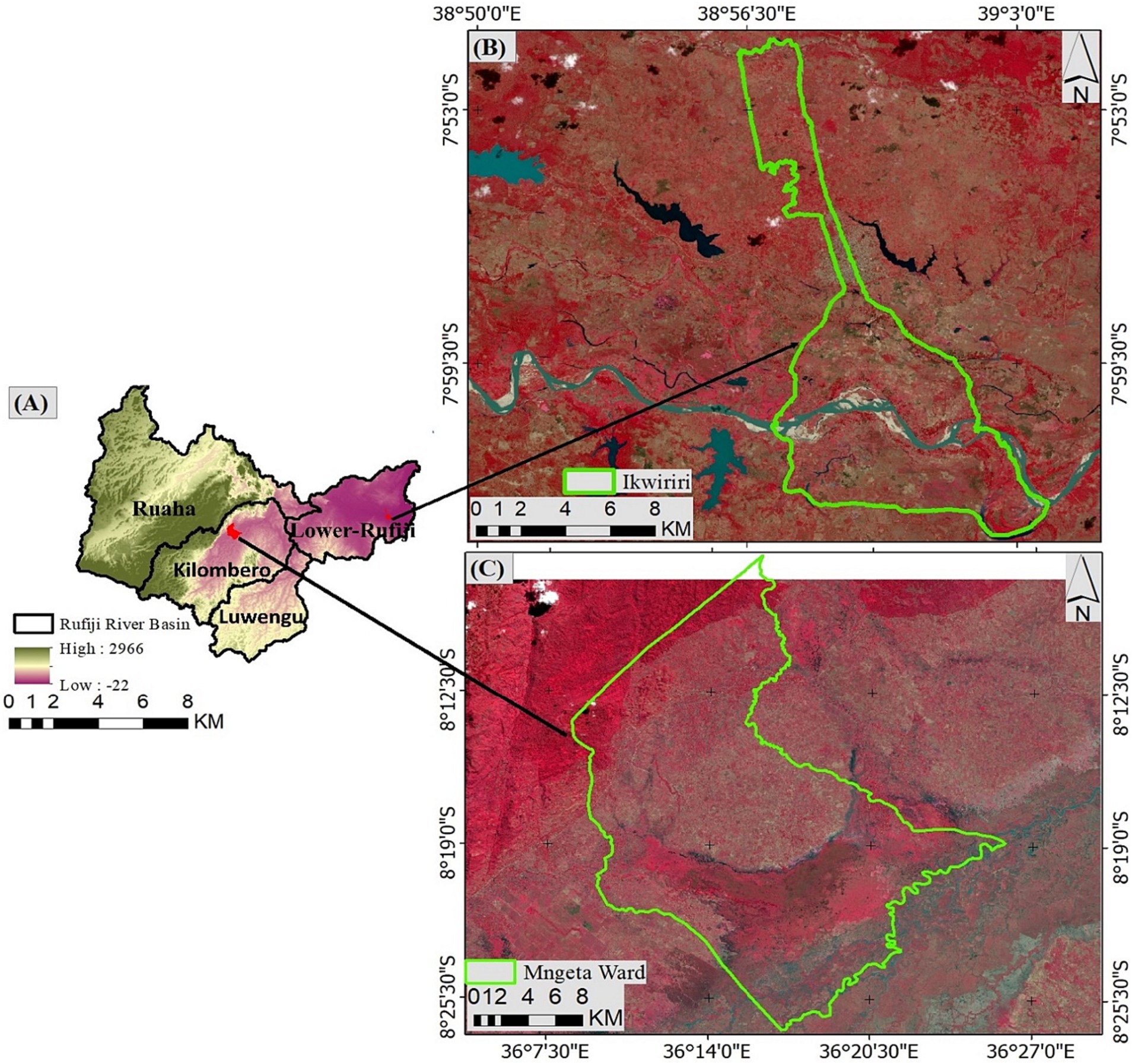
Figure 1. Map of the study areas. Letters (A) indicate Rufiji basin, (B) is Ikwiriri ward, and (C) is Mngeta division (covering Mbingu and Mofu wards).
The Kilombero sub-basin is characterized by abundance of rivers, tributaries and a floodplain that undergoes seasonal flooding. The climate of the basin is humid, with temperatures ranging from 26 to 32°C. The basin experiences an average yearly precipitation of 1,200 to 1,400 millimeters (Gebrekidan et al., 2020). The fluctuations in water levels are significant, with the flooding during the rainy season and drying up during the dry season, apart from the rivers and river margins. With over 80% of its arable area monocropped with rice, the floodplain of Kilombero basin serves as Tanzania’s major rice basket, producing 9% of the country’s total rice production (Höllermann et al., 2021).
The Lower Rufiji Basin, located in Southeastern Tanzania, encompasses the Rufiji River and its floodplain, and is an important source of livelihood for its local population through farming, fishing, and forestry. The floodplain of Rufiji River experience seasonal flooding due to Rufiji River overflow as it collects water from other upstream sub-basins, Kilombero, Luwengu, and Ruaha. Floods in the floodplains of the Rufiji River can be beneficial for rice cultivation as it deposits fertile sediments but it also causes damage to infrastructure and crops. The communities within Lower-Rufiji area are among economically underdeveloped in the nation (Duvail and Hamerlynck, 2007).
2.2 Sampling design and data collection
The study employed a mixed-methods approach that combined both quantitative and qualitative data collection from the study areas. The quantitative data were obtained from a survey of households in the study areas, using a random sampling technique and a semi-structured questionnaire. The qualitative data were obtained from in-depth interviews with key informants who were involved in agricultural activities and development projects in the study areas.
The respondents for the household survey were selected from two study locations, Mngeta and Ikwiriri. Each location served as a distinct stratum with unique geographical attributes. Within each stratum, households were randomly selected from the village record books using an online random number generator (Georgiev, 2020). In total, 180 households were interviewed: 119 in Mngeta and 61 in Ikwiriri. For the in-depth interviews, key informants were purposively selected based on their roles and experiences related to flood stress. These informants included eight agricultural extension officers and two district statisticians. Potential biases in our sample could arise from non-response bias if certain households chose not to participate in the survey. Additionally, difficulties in reaching some of the respondents due to geographical constraints and weather conditions could also introduce bias into our sample.
Data collection was done through semi-structured questionnaires and in-depth interviews that were administered to household respondents and key informants, respectively. Before household surveys in the sample villages, we pre-tested our research instruments in two villages outside the main study villages, and then, questions were improved accordingly (Nanda et al., 2013; Ikart, 2019). Questionnaires were uploaded in the digital data collection tool called Kobotool Box that simplified data collection process and eventually storage and retrieval. All surveys were conducted with informed consent form and respondents were assured of anonymity and confidentiality. The questionnaires and interviews were prepared in English and then translated into national language, i.e., Swahili. To ensure that farmers are comfortable and have good understanding of the asked questions, we slowly introduced questions to the farmers. While farmers delivered individual perceptions, key informants gave details that pointed out the patterns observed across several farms. Transect walks were performed to validate data given by farmers as well as collection more information from the study areas.
2.3 Data analysis
IBM SPSS Statistics version 29 was used to code and analyze the data collected from household questionnaires. The questionnaires contained variables of interest as shown in Table 1. We performed descriptive statistics on these variables to obtain frequencies, means, and percentages. Out of 180 respondent farmers, 179 were included in the subsequent analysis since one farmer gave incomplete responses. We also used descriptive statistics to characterize the rice production systems and the experiences of flood stress and other abiotic stresses among the respondents.
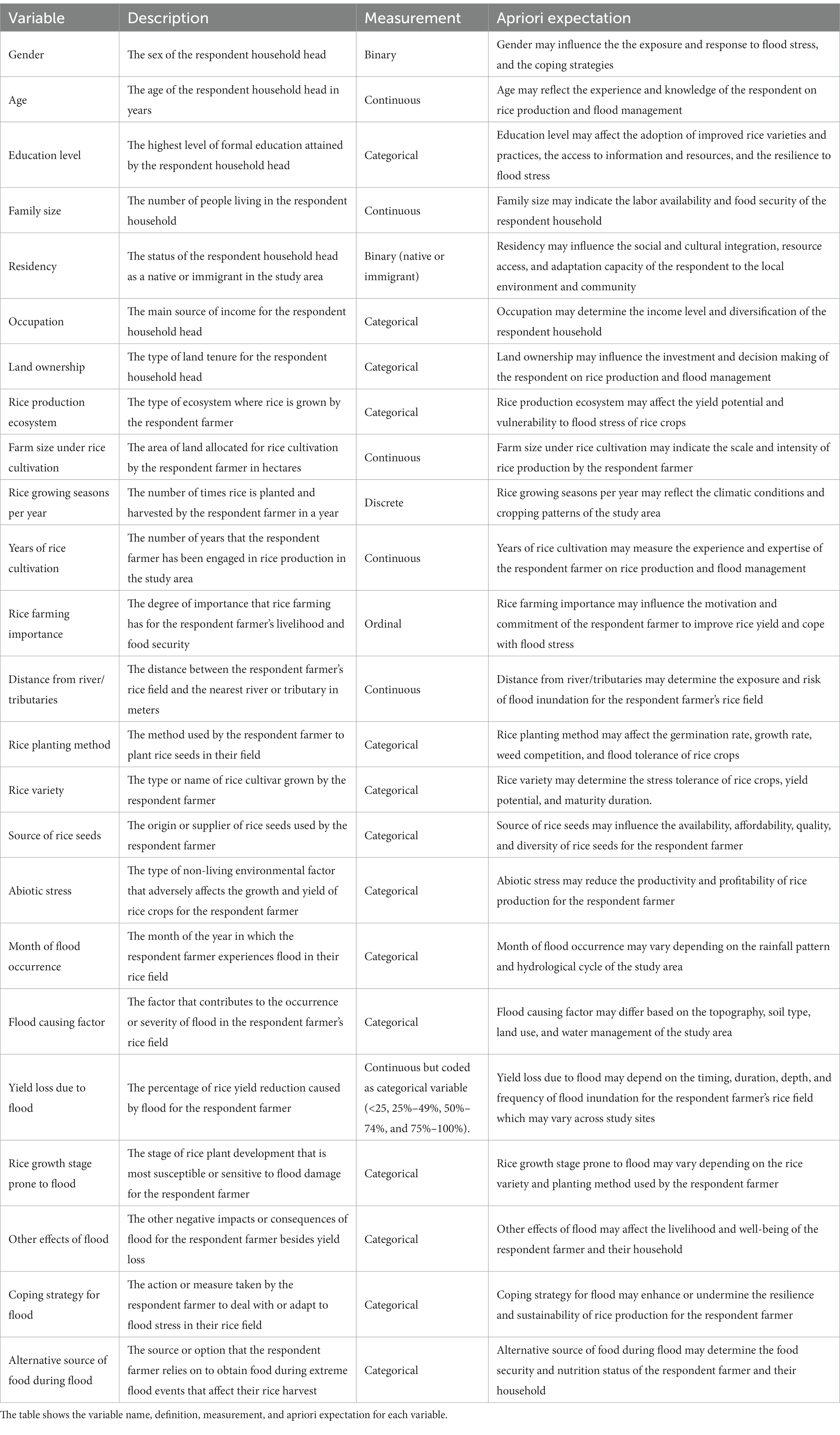
Table 1. Description of the variables used in the analysis of rice production and flood stress in Ikwiriri and Mngeta sub-basins.
We calculated the percentage rice yield losses experienced by farmers using the following formula in equation. 1, and then computed chi-square to understand variation of yield losses across study sites. Responses from a total of 167 farmers with at least 5 years of experience were included in computing yield loss percentages.
The relationships between different variables were examined using crosstabulation and chi-square tests at 95% confidence level. The normality distribution of continuous variables was also checked using Shapiro–Wilk test. Microsoft Excel 2016 and ggplot2 function in R version 4.1.1 were used to construct data graphics and tables.
Besides the household questionnaires, key informant interviews were also conducted with 14 experts and community leaders who had relevant knowledge and experience on rice production and flood stress. These interviews were used to supplement and validate the findings from the questionnaires. The interview data were analyzed by identifying the main themes and perspectives that informants shared on the causes, effects, and solutions of flood stress on rice yield.
3 Results
3.1 Demographic profile of the respondent households across study areas
Demographic characteristics of respondent farmers from two study locations, Ikwiriri (n = 61) and Mngeta (n = 119) with a total of 180 lowland rice farmers (Table 2). Gender distribution of household heads showed a significant difference between two locations, with 33.9% female farmers in Mngeta and only 18% in Ikwiriri (p < 0.05). The majority of farmers in both locations were male (82% in Ikwiriri and 66.1% in Mngeta). Both locations had a similar age distribution, with the majority of farmers being 30–45 years old. Mngeta had a higher proportion of farmers under 30 and over 60 compared to Ikwiriri.
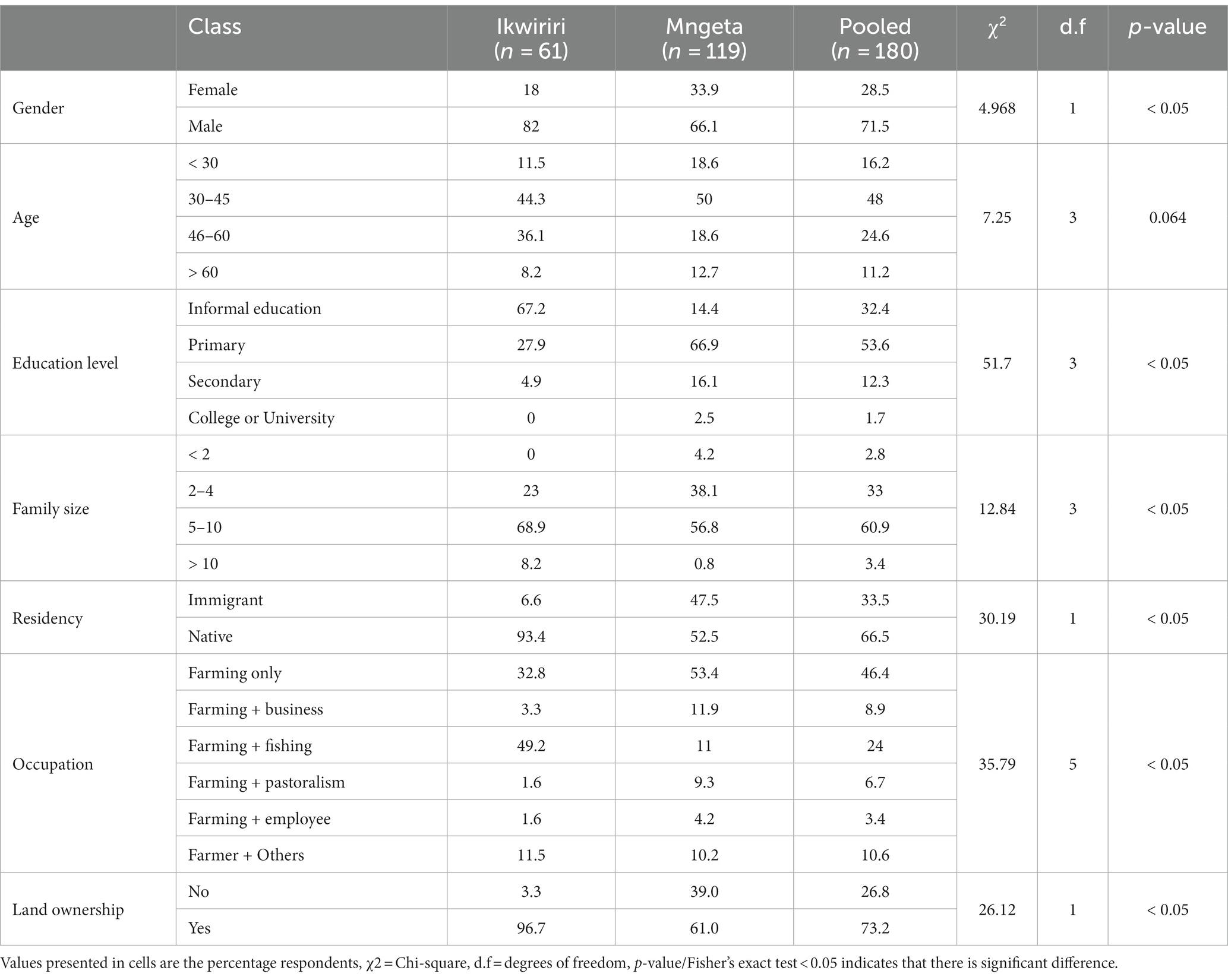
Table 2. Demographic characteristics of respondent household heads of Ikwiriri and Mngeta in the Rufiji and Kilombero sub-basins, respectively.
Education levels of farmers in Ikwiriri and Mngeta differed significantly (p < 0.05), with 67.2% of farmers in Ikwiriri and 14.4% in Mngeta having only informal education. Meanwhile, Mngeta had a higher percentage of farmers with primary education at 66.9% compared to Ikwiriri 27.9%. Both locations had a similar average family size of 5–10 members, however, Mngeta had a higher proportion of families with 2–4 members at 38.1% compared to Ikwiriri 23%. In addition, majority of farmers in Ikwiriri were native residents 93.4% whereas nearly half (47.5%) respondent population in Mngeta were immigrants from other parts of the country.
There was a significant difference in respondent’s occupations between two locations, with 53.4 and 32.8% of farmers in Mngeta and Ikwiriri being solely engaged in farming activities, respectively. A higher percentage of farmers in Ikwiriri were involved in farming and fishing (49.2%) compared to Mngeta (11%). Majority of farmers (73.2%) in the study areas are land owners, but the difference across study sites was significant (p < 0.05) with Ikwiriri having more land owners (96.7%) compared to Mngeta (61%).
3.2 Important crops grown for food security and livelihood
Farming plays a crucial role in providing both livelihood and food security in the two areas under study. Oryza sativa (Rice) and Zea mays (maize) are the main crops grown in the regions, primarily for self-consumption and to generate income (Figure 2). Typically, rice is cultivated in fields that are periodically flooded, while maize and other annual crops such as pumpkins and vegetables are grown using residual moisture after rice harvest. Additional crops such as Musa spp. acuinata (banana), Theobroma cacao (cocoa), Anacardium occidentale (cashew), and Sesamum indicum (simsim) are cultivated predominantly to generate income.
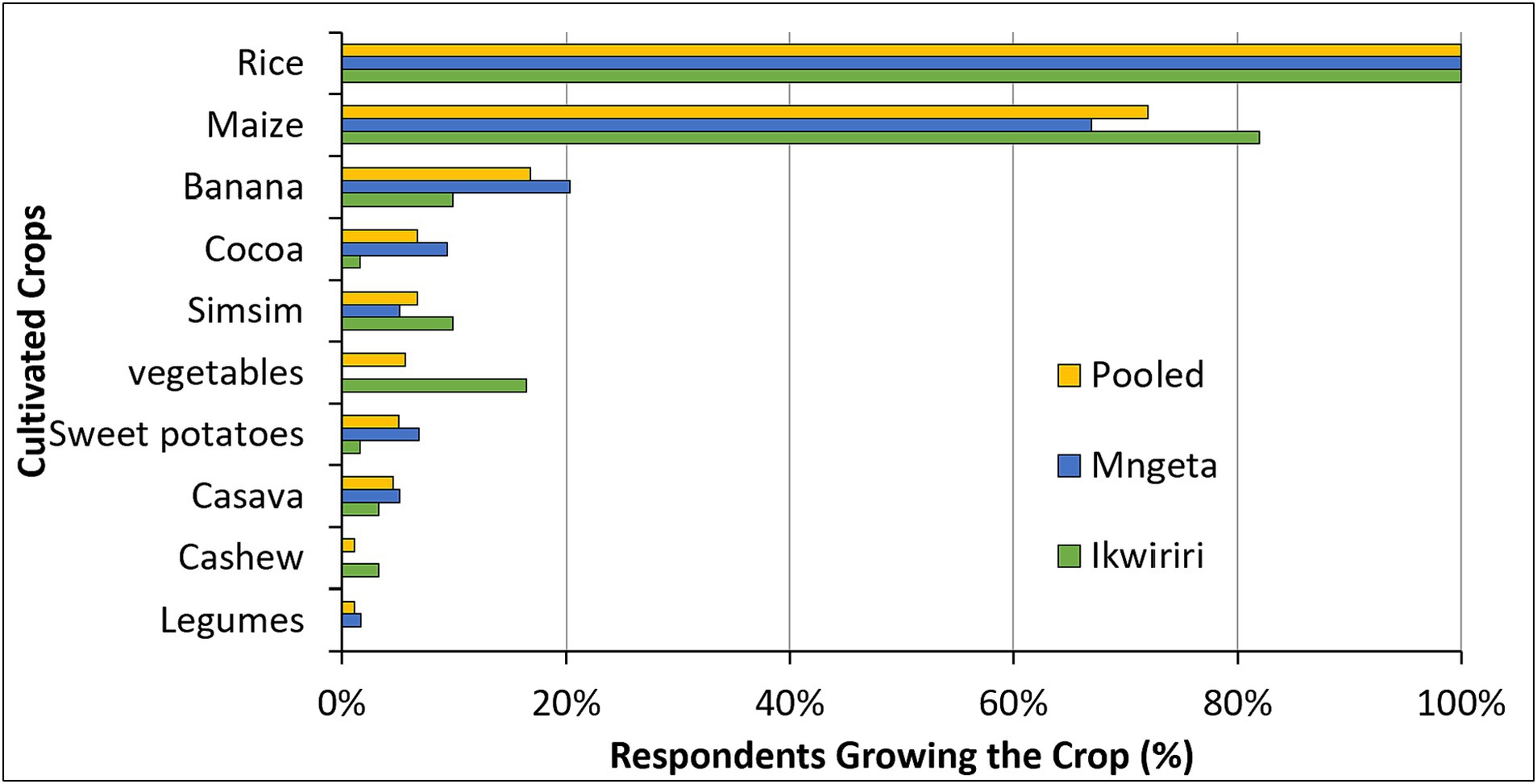
Figure 2. Dominant crop types cultivated in Ikwiriri and Mngeta in the Rufiji and Kilombero sub-basins, respectively. The values are based on respondents from a total of 179 household heads.
3.3 Characterization of rice production systems
Results in Table 3 relates to lowland rice production across study areas and provides information about the characteristics of the rice production systems. Ikwiriri and Mngeta have a 100% rainfed lowland rice production ecosystem, with no presence of irrigated or rainfed upland systems. Majority of rice farms cumulative sizes in two study areas are between 1 and 4 acres (79.9%), where most farms are typically separated into smaller plots of land that are scattered across a wider area rather than being located together in a single contiguous area. Majority of the farmers grow rice in one season per year (99.4%) and have been cultivating rice for 5–15 years (43.6%). Rice farming is considered highly important to 96.1% of the farmers. The distance from rivers and tributaries varies, with the largest percentage of farmers (35.8%) located between 0.5 and 1 km away. The majority of farmers (89.4%) plant rice through direct seeding, with 10.6 of them combining transplanting and direct seeding method. The most common direct seeding method used is broadcasting (79.35%). A small percentage of farmers (13.4%) used mechanized planting method, while the majority (86.6%) use hands in planting seedlings. The results of the chi-square test indicate that there are significant differences in years of rice cultivation (p < 0.05) and planting method (p < 0.05). The variation in year of cultivation can be attributed to age demographics of the farming population. These differences are crucial as they can impact the farmers’ accumulated experience and knowledge in managing flood-related stresses. A more extensive background in rice cultivation could potentially equip farmers with a broader range of strategies to cope with such stresses. The method of direct seeding also showed significant differences (p < 0.05).
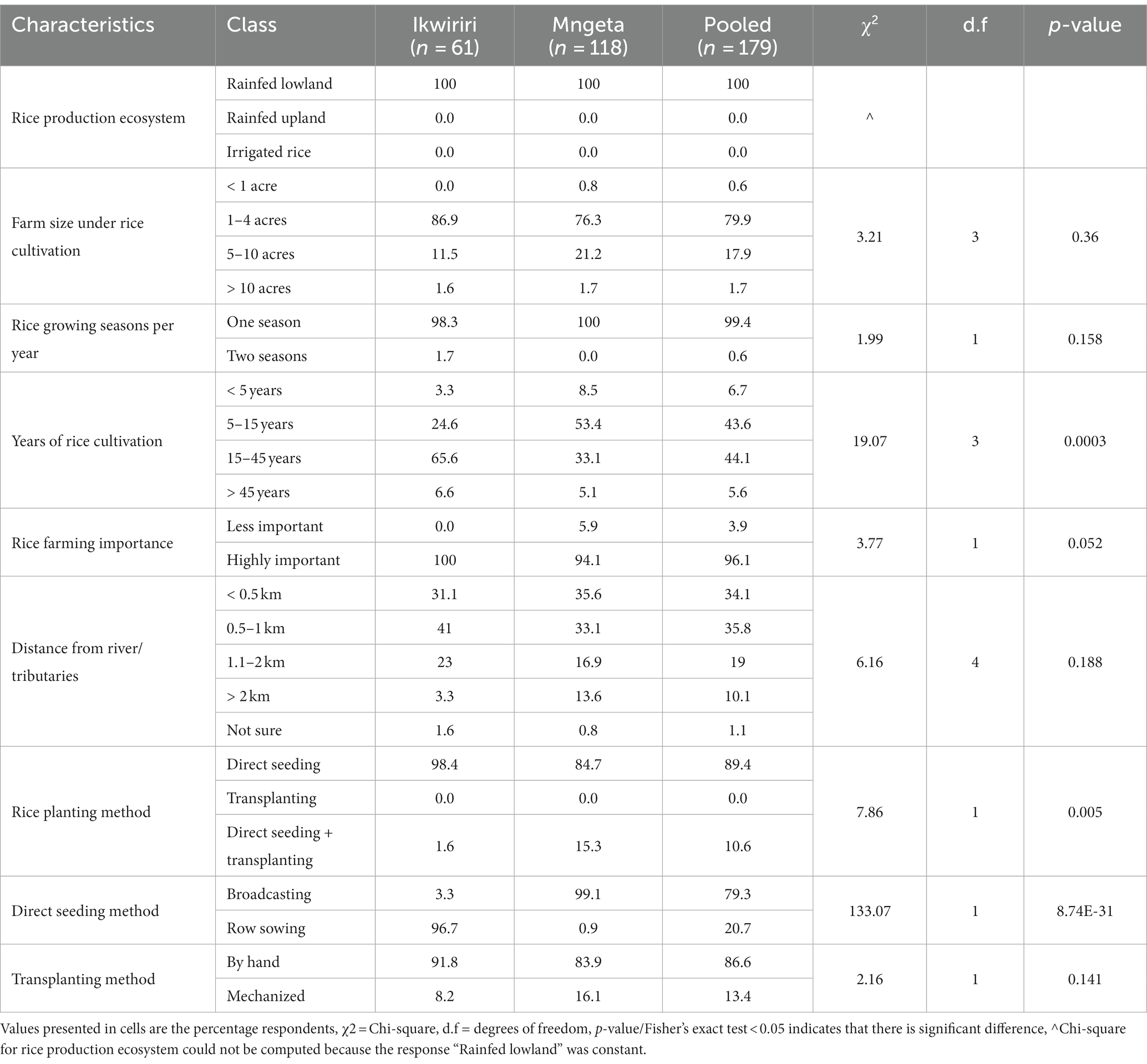
Table 3. Rice farming characteristics and practices utilized by respondent farmers of Ikwiriri and Mngeta in the Rufiji and Kilombero sub-basins, respectively.
3.3.1 Cultivated rice varieties and sources of seeds in the study areas
The choice of variety for cultivation is one of the crucial decisions for rice production sustainability. Majority of the farmers in the two sites largely opted for traditional rice varieties and rarely cultivates improved rice varieties (Figure 3). Almost 97% of the varieties mentioned were landraces while SARO 5 (TXD 306) was the only improved variety cultivated by few farmers across study areas (Figure 3). The use of improved cultivar., specifically Saro 5, was high in Mngeta (24%) while than in Ikwiriri (2%). More than 50% of farmers in Ikwiriri mentioned Chale as their dominant rice variety followed by Afa (33%) and Kikoti (18%) unlike Mngeta where 43% of farmers declared Zambia as their dominant rice variety followed by Kalimata (40%) and Mbawambili (28%). With reference to the mentioned rice varieties, 19 rice varieties representing 65.5% were mentioned to be used with less than 10% respondents. Therefore, this indicates the diversification of rice varieties at varied degree of preference.
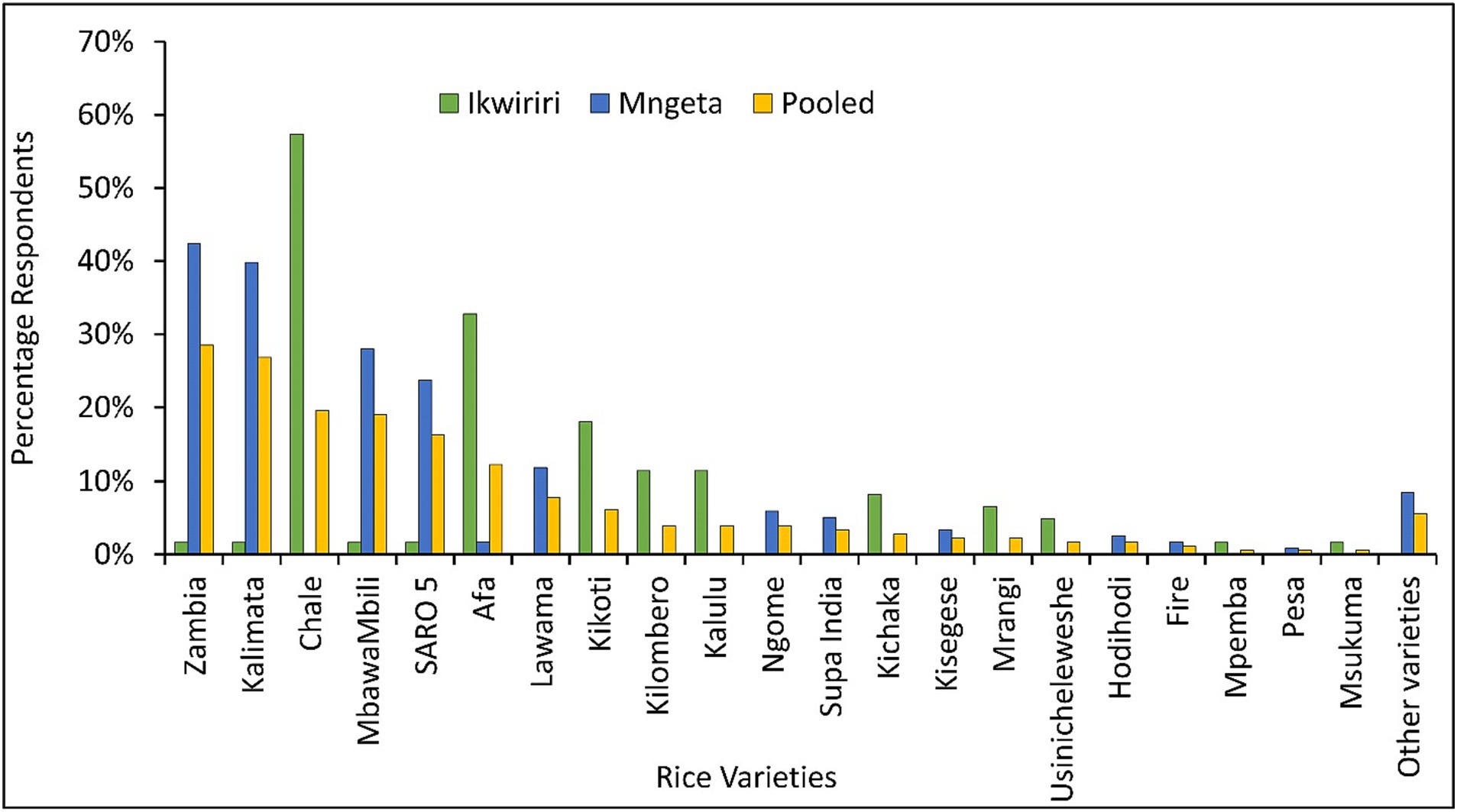
Figure 3. Prominent rice varieties which are grown by lowland rice farmers of Ikwiriri and Mngeta in Rufiji and Kilombero sub-basins, respectively (n = 179).
The sources of rice seeds utilized in two study areas are displayed in Table 4. The findings reveal that the majority of farmers in both Mngeta (80.5% and 72%) and Ikwiriri (100.0% and 72.1%) cultivate recycled seeds and seeds acquired through farmer-to-farmer exchange, respectively. Meanwhile, utilization of seeds from commercial companies, TARI, and ASA was minimal, only less than 1.7% of farmers in both sites utilize these sources. A Chi-square test showed a significant difference only in the usage of recycled seeds between the two areas (p < 0.05).
3.4 Farmer’s experience of dominant stresses in rice production
In the river basins under study, rice production has been observed to be impacted by variety of biotic and abiotic factors (Table 5). Majority of farmers across both study sites reported having experienced floods (99.4%) and pest and diseases (83.2%) as stressors, while none of them reported soil salinity as a stressor. Less than 50% of farmers in both sites reported having experienced extended periods of drought, cold, or extreme heat. However, a higher percentage of farmers in Ikwiriri (42.6%) reported experiencing an extended period of drought compared to those in Mngeta (26.3%). Similarly, a higher percentage of farmers in Mngeta (9.3%) reported experiencing extreme heat compared to those in Ikwiriri (4.9%). The results also show that the difference in the farmer’s experience of extended periods of drought (p = 0.026) and pest and diseases (p < 0.05) was statistically significant, while the differences in the farmer’s experience of floods, cold, extreme heat, and soil salinity were not significant (p > 0.05). In summary, the results suggest that floods and pest and diseases are the dominant stressors in lowland rice production across both study sites. The difference in the farmer’s experience of extended periods of drought and pest and diseases between the two study sites is statistically significant, indicating that these stressors may be site-specific (experienced differently across locations).
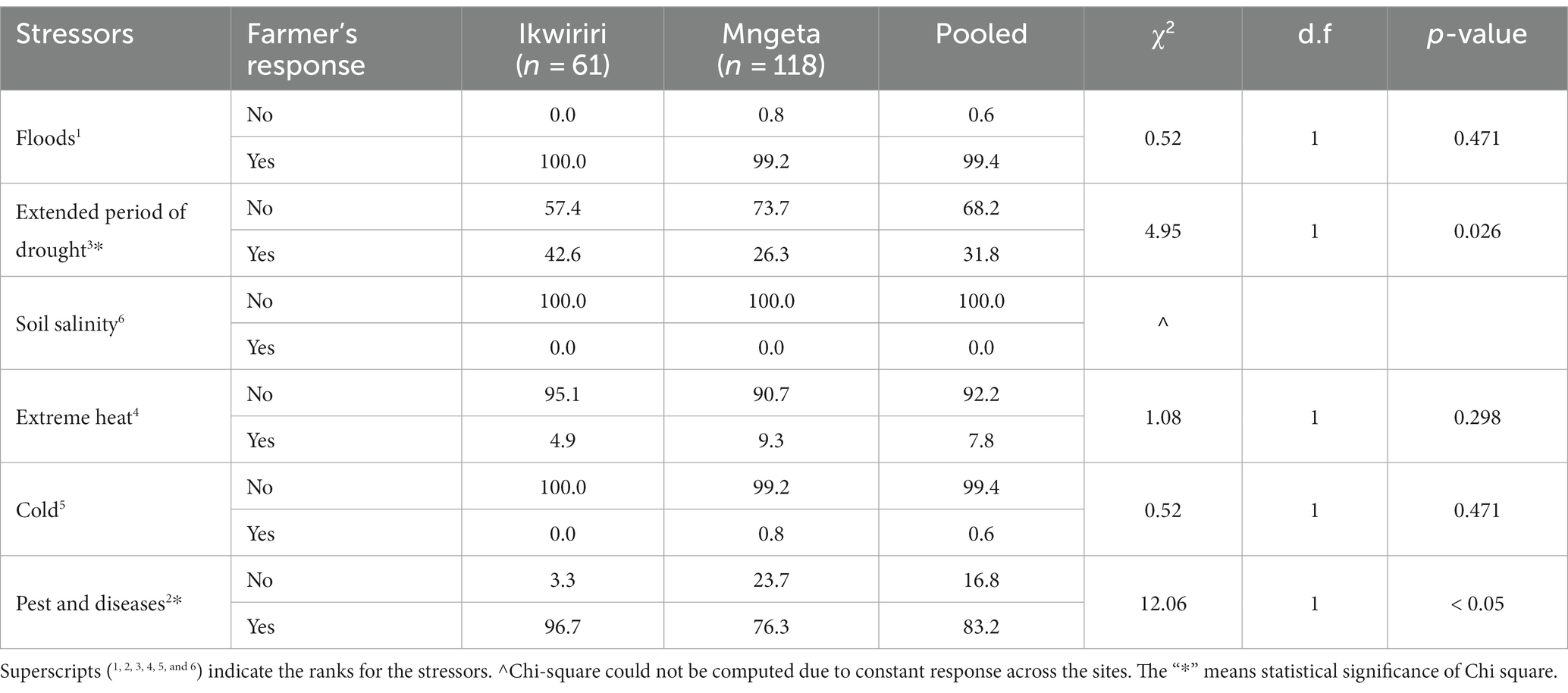
Table 5. Farmer’s experience of the dominant abiotic and biotic stressors across the two study sites; Ikwiriri and Mngeta.
The findings also revealed existence of multiple stressors rather than the presence of stressors in isolation. The interplay between biotic and abiotic factors in the two study areas results in farmers facing multiple stressors within a single growing season (Figure 4). The most prevalent forms of coexistence were: (i) floods and pest and diseases and (ii) a triple combination of floods, prolonged drought, and pest and diseases. While the former combination is equally a challenge in both sites, the latter is significantly more pronounced in Ikwiriri (p < 0.05). Less than 10% of the stressors in Ikwiriri and less than 20% in the Mngeta sites resulted from combinations other than those mentioned above. Besides, sole occurrences of a single stressor are very minimal in both sites.
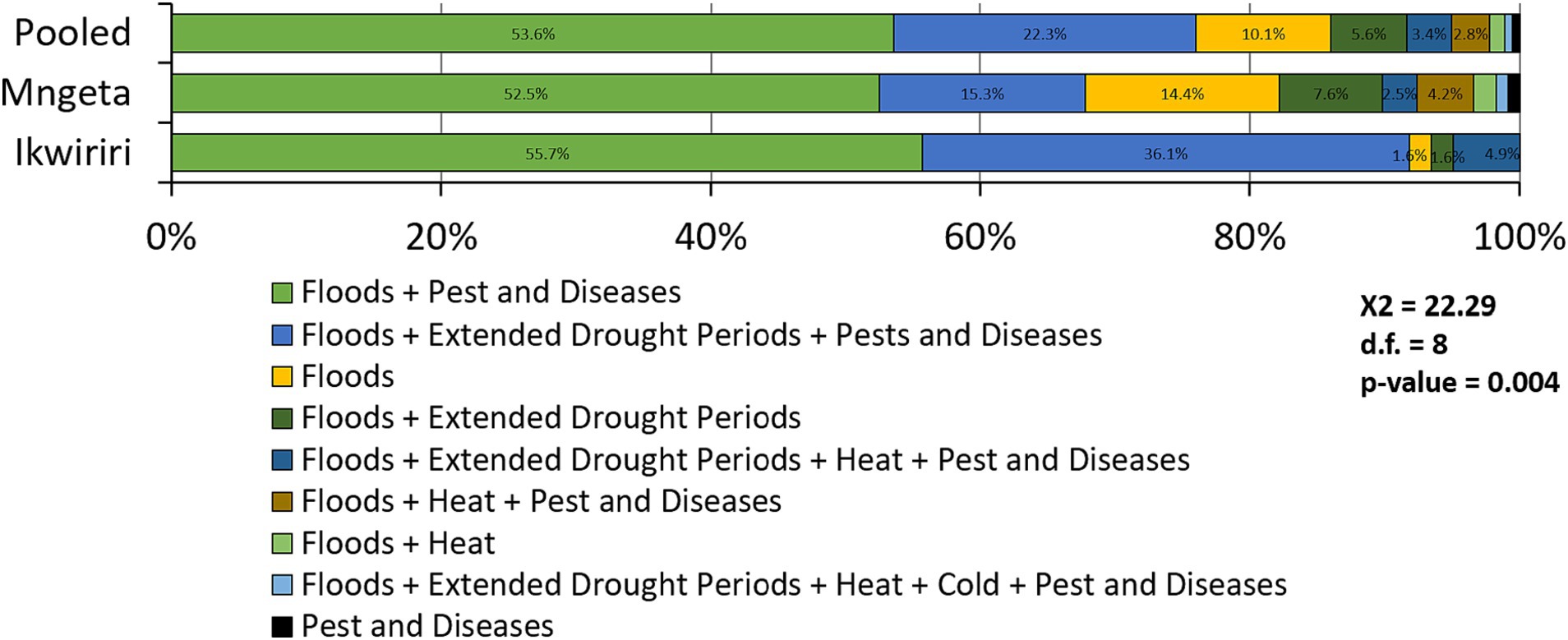
Figure 4. Farmer’s experience on dominant stressors they encounter in their lowland rice farms in Ikwiriri and Mngeta sites (n = 179).
3.5 Farmer’s experiences and perceptions on floods dynamics and factors causing floods
We asked farmers about the months of the year in which they experience floods. The results showed that floods occur between December and May, covering both the short and long rainy seasons (Figure 5). The majority of respondents from both study sites (over 80%) reported experiencing floods during March and April, during the long rainy season. A few farmers reported experiencing floods towards the end of the long rainy season in May. Only less than 20% of respondents reported experiencing flooding between December and February.
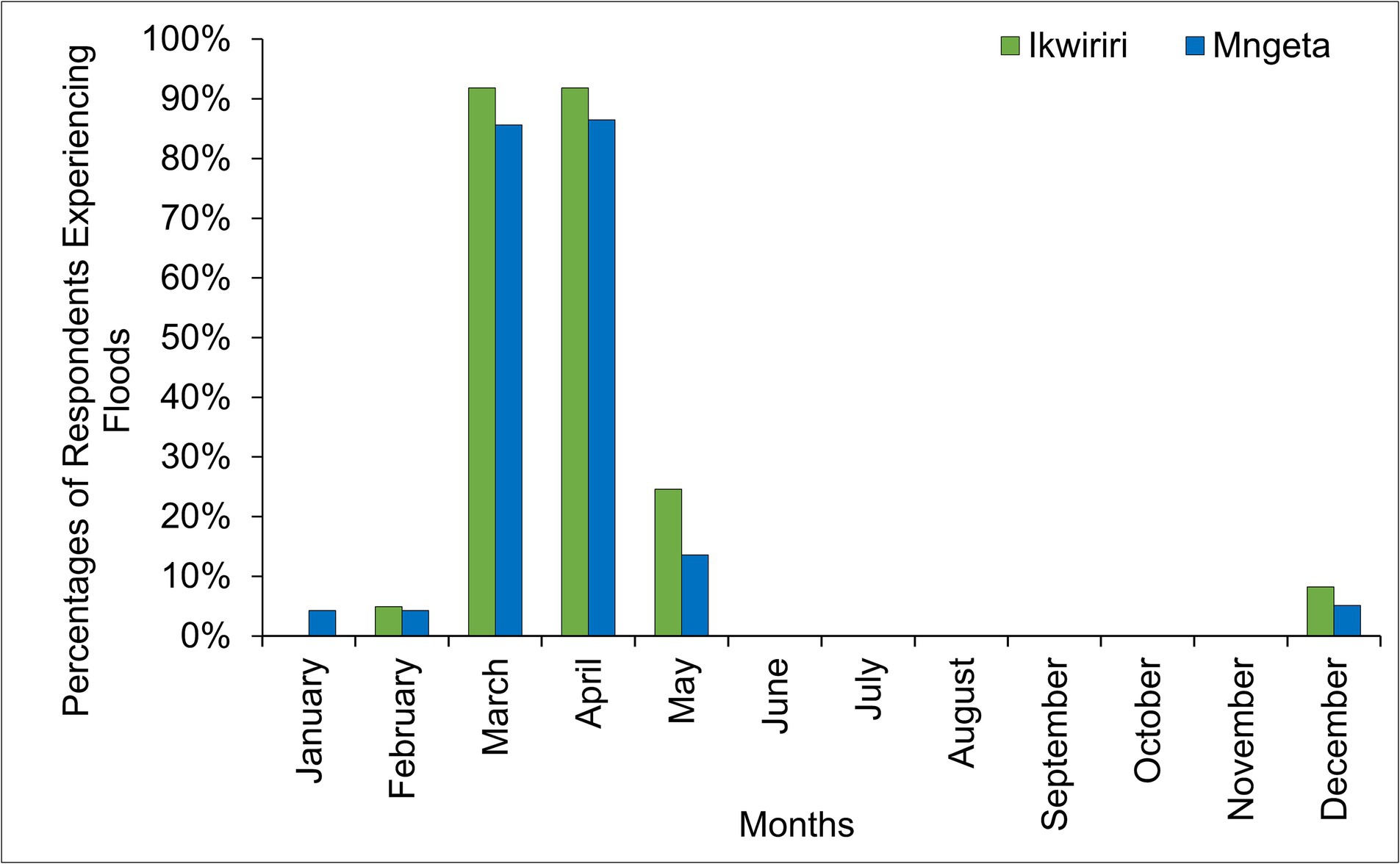
Figure 5. Farmer’s response on months of the year in which they mostly encounter floods in their farms in Ikwiriri and Mngeta. The percentages indicate proportion of farmers who responded “Yes” to whether or not they face floods in that specific month (n = 179).
The rice crop calendar in both basins starts with land preparation in November and early December, before the onset of heavy rains. As per extension officers of two study areas, rice planting (Largely through direct seeding) begins in mid-December to late-January, when floods are rare. If floods occur in January, farmers pre-germinate their rice seeds and broadcast them to prevent germination failure due to anoxic condition of the soils which could result into anaerobic seed germination. During March and April, vegetative submergence of rice is common when floods occur, and in some cases, water may persist until harvest time. One of the extension officers in Mngeta stated, “Sometimes harvesting has to be done by boats (Mitumbwi) due to the stagnant water in some rice fields”.
A number of factors that have been reported to precede floods (Table 6). Majority of farmers in Mngeta (60%) and few in Ikwiriri (11.7%) agreed that rain would result in flooding signifying the difference between geolocations (p < 0.05). The most persuasive cause of flooding was found to be the river and its tributaries overflowing, with 95.0% and 87.0% respectively, in Ikwiriri and Mngeta perceiving it as flood-causing factor. Since the Rufiji River collects water from aforementioned sub-basins (Kilombero, Luwengu, and Ruaha), it frequently overflows during periods of heavy rain causing floods in Lower-Rufiji sub-basin where Ikwiriri ward is located. When there are heavy rains in the Kilombero basin (where Mngeta is located), water from the Ozdungwa mountains typically overflows the rivers and its tributaries, triggering flooding in the rice fields adjacent to the rivers and tributaries.
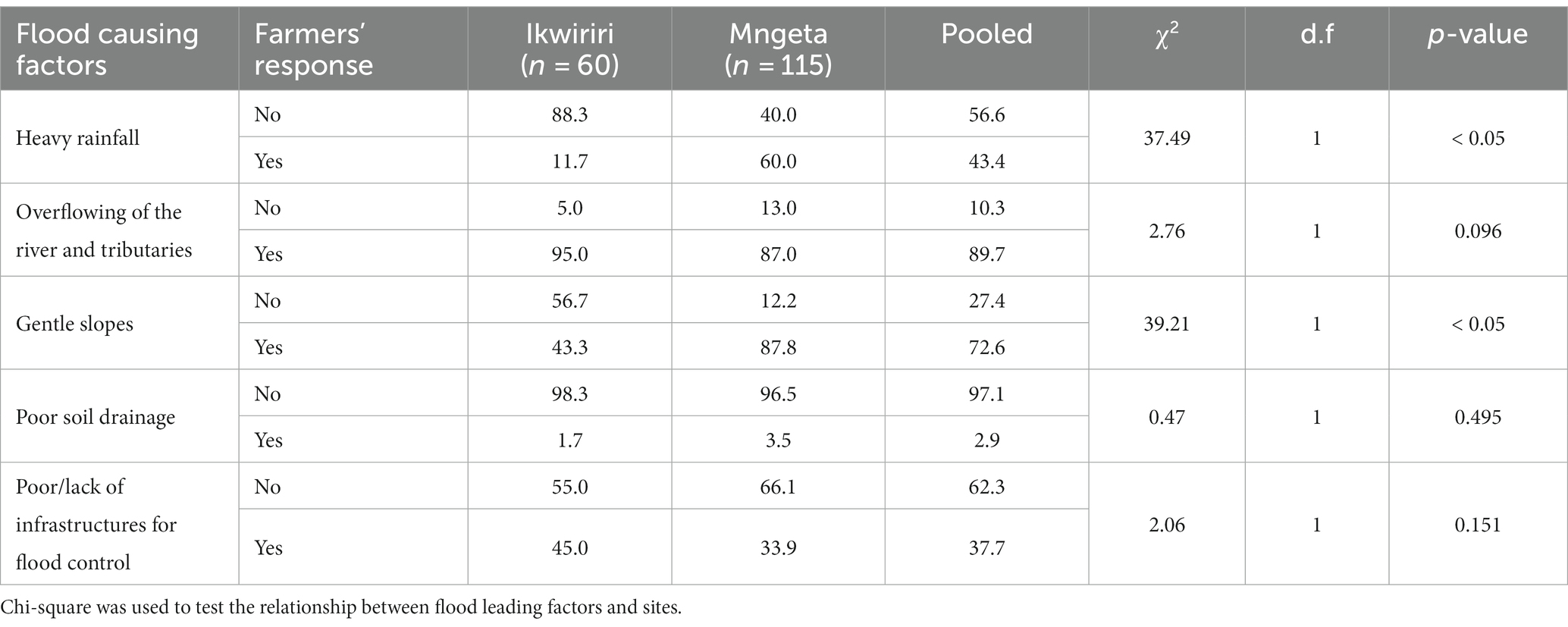
Table 6. Farmer’s insights on factors leading to floods in their lowland rice farms in Ikwiriri and Mngeta sites.
Farmers in two study locations also linked the occurrence of floods to gentle slopes. In Mngeta, 87.8% of farmers acknowledged that gentle slopes also cause floods, compared to only 43.3% of farmers in Ikwiriri. This difference is statistically significant (p < 0.05). Floods in two sites were also associated with lowland rice producers’ poor or nonexistent infrastructures for flood control. In Ikwiriri and Mngeta, respectively, 45% and 33.9% of farmers attributed poor or nonexistent infrastructure for flood control as a causing factor of floods. In an interview with the Office of DAICO of Mlimba DC, they made the point that uneven fields without drainage canals, changes in river morphology caused by farmers cultivating rice closer to the banks, and other factors all contribute to the floods in Mngeta. The least acknowledged element accelerating flooding in the two research areas was poor soil drainage.
3.6 Impacts of floods on rice farmers
3.6.1 Crop losses due to extreme floods
The perceived crop losses across the study sites were determined by comparing the yields from years with minimal and severe flooding. Farmers were surveyed about their flood-related losses and regular harvest during dry periods, based on their five-year experience. Only farmers with at least five years of experience producing rice were included in the responses. Results showed that farmers at the two study sites had different experience of rice yield losses. Farmers in Ikwiriri suffered greater losses compared to those in Mngeta. In Ikwiriri, 20% of the farmers reported losing between 50 and 74% of their crop yield, while 80% reported losing between 75 and 100%. The DAICO’s office in Rufiji District highlighted that while extreme flood events typically result in huge crop losses, mild floods seldom lead to significant damage. The farmers in Ikwiriri cope with total loss by replanting the rice if time allows, and by changing to different crops using the residue moisture when floods recede, or relying on fishing for food and income. In Mngeta, 50% of the farmers experienced losses between 50% and 74% due to floods, 38% reported losses between 25% and 49%, and less than 10% reported complete crop losses or no losses at all (see Figure 6).
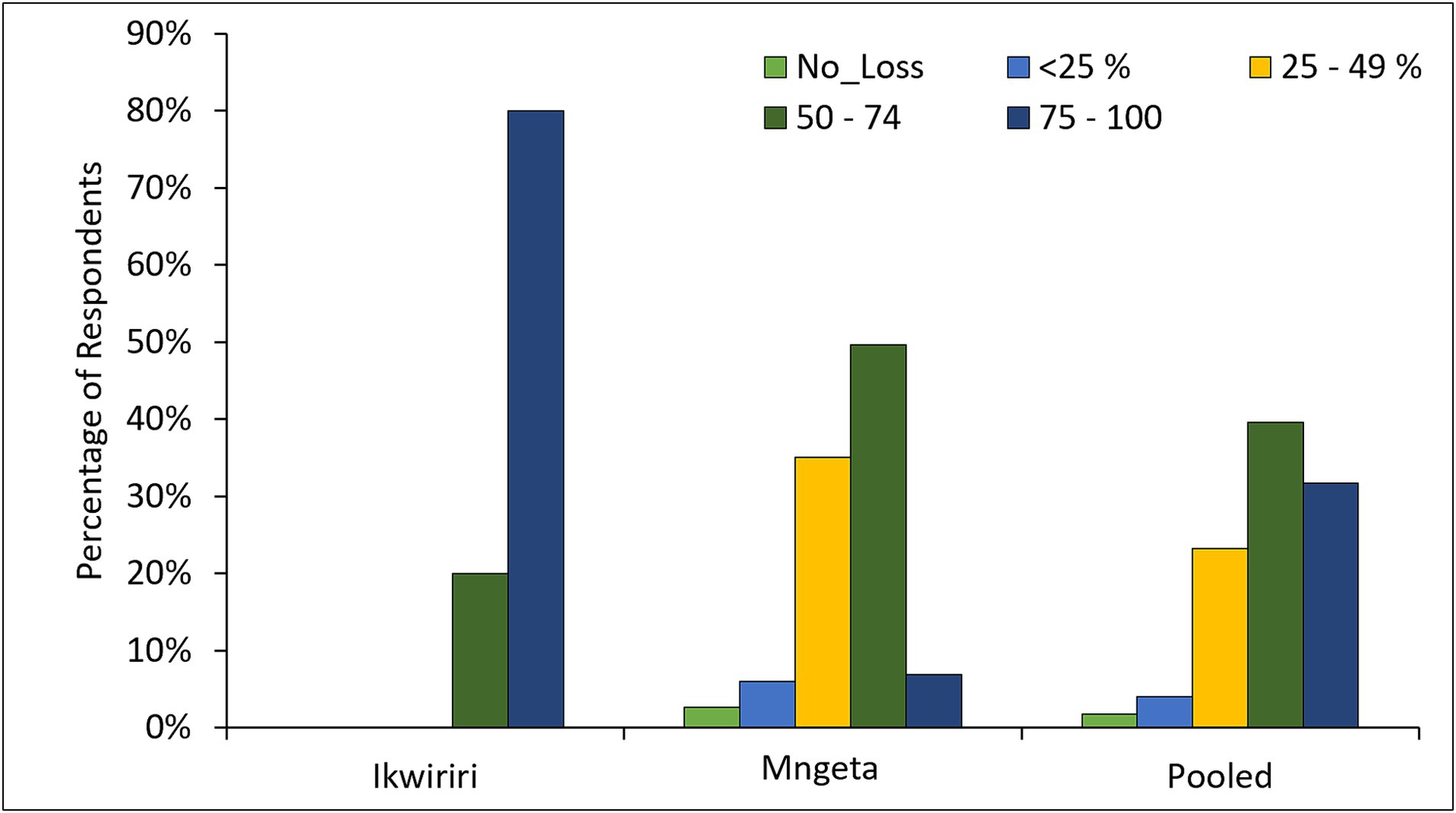
Figure 6. Percentage of respondents reporting different levels of yield losses due to extreme floods in Ikwiriri and Mngeta. The number of farmers with at least 5 years of farming experience (n) were 167 (59 for Ikwiriri and 108 for Mngeta).
We further explored on farmer’s experience of the growth stages and planting methods which are most flood-vulnerable. Figure 7 present farmer’s experience on rice growth stages and planting methods that are prone to flooding across two study sites in Ikwiriri and Mngeta. Results reveal that majority of farmers in both Ikwiriri (91.7%) and Mngeta (97.4%) believe that the seeding stage is the most vulnerable to flooding. The results also show that a significant number of farmers in both sites experienced losses during the transplanting stage (18.3% in Ikwiriri and 69.8% in Mngeta). The tiller formation stage is also found to be vulnerable to flooding, with 78.3% of the farmers in Ikwiriri and 45.7% in Mngeta reporting losses during this stage. The results also indicate that the flowering (85.0% in Ikwiriri and 38.8% in Mngeta), grain filling (78.3% in Ikwiriri and 34.5% in Mngeta), and harvesting (50.0% in Ikwiriri and 53.4% in Mngeta) stages are also susceptible to flooding, but to a lesser extent. The differences in the farmers’ responses between the two study areas are significant for all growth stages (p < 0.05), except for harvesting stage (p = 0.664).
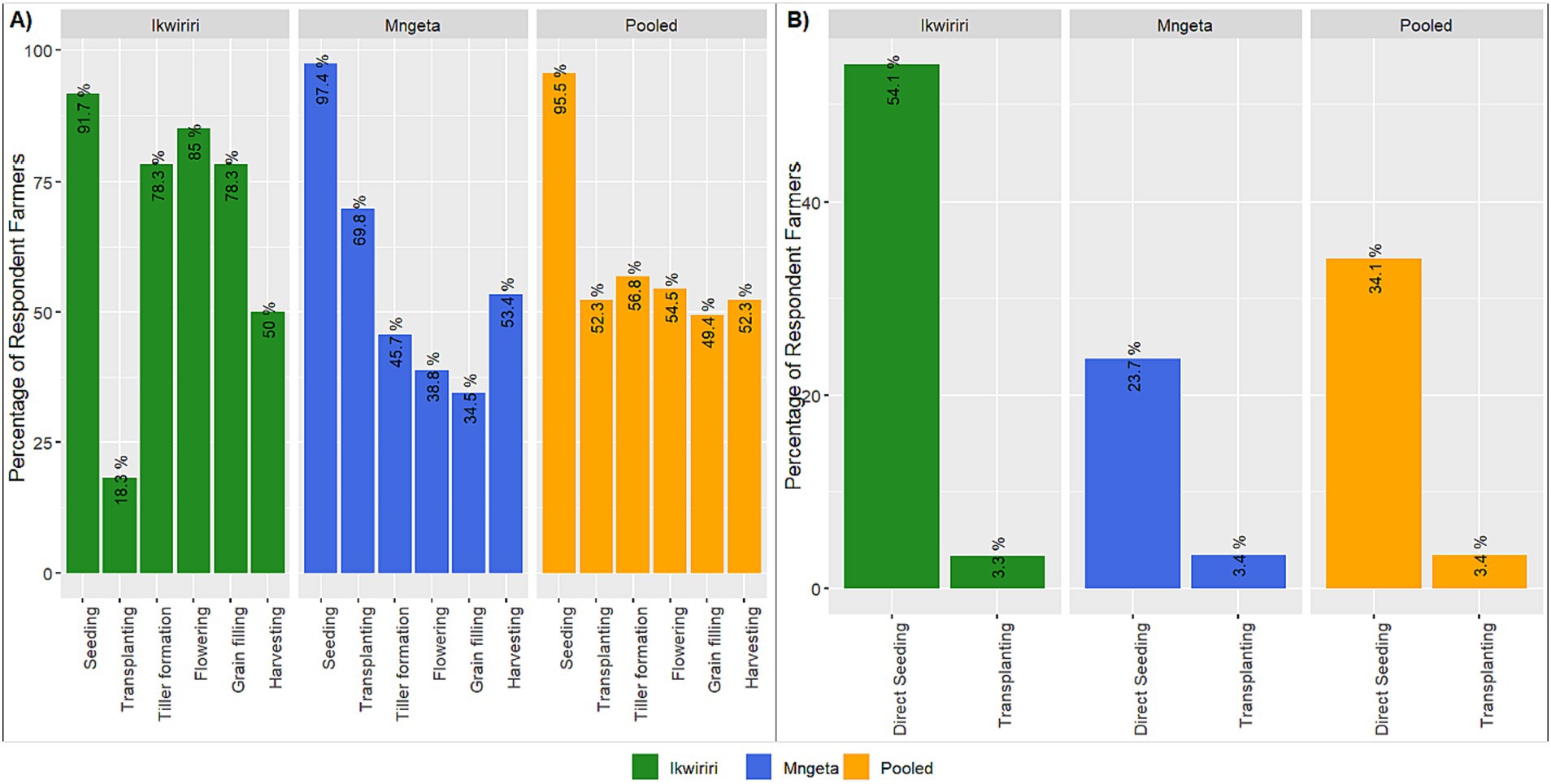
Figure 7. Farmer’s experience on rice growth stages (A) and (B) Planting methods that are prone to flooding (n = 179).
The results of the survey also indicate that direct seeding is the most vulnerable planting method to flooding, with 54.1% of the farmers in Ikwiriri and 23.7% in Mngeta reporting losses when using this method (Table 3). On the other hand, transplanting is found to be the least vulnerable planting method, with only 3.3% and 3.4% of the farmers in Ikwiriri and Mngeta reporting losses, respectively.
3.6.2 Other effects experienced by farmers
The impacts of floods are not limited to just rice crop losses. Farmers in two study areas face additional negative consequences that harm their livelihoods, as shown in Table 7. Many farmers have reported giving up all or part of their farms due to difficulties in planting or managing crops during floods, with farmers in Ikwiriri ward having the highest abandonment rate of the pieces of land most vulnerable to flooding (96.7%) compared to farmers in Mngeta wards (64.4%). It’s statistically significant (p < 0.05) to say that Ikwiriri farmers are more likely to abandon their rice fields due to floods. Renting or selling flood-prone farms was also reported by some farmers in both areas, but the number of farmers who do so was not significantly different between the two locations (p < 0.05).
Flood episodes were frequently linked to fatal diseases that reduce manpower, including Malaria, Typhoid, Bilharzia, and Cholera. Malaria was the most common, followed by Typhoid, Bilharzia, and Cholera. Malaria and Bilharzia were more prevalent in Ikwiriri, while Typhoid was more common in Mngeta. There was no significant difference in responses regarding Cholera between the two locations (see Table 7).
3.7 Rice farmer’s coping strategies to extreme floods events
To cope with floods events, lowland rice farmers of Ikwiriri and Mngeta are deploying assortment of strategies ranging on-farm methods such as adjusting the planting schedule, use of early or late maturing varieties, use of tolerant varieties, to after-flood strategies such as recession farming, and changing to other crop or economic activities (Table 8).
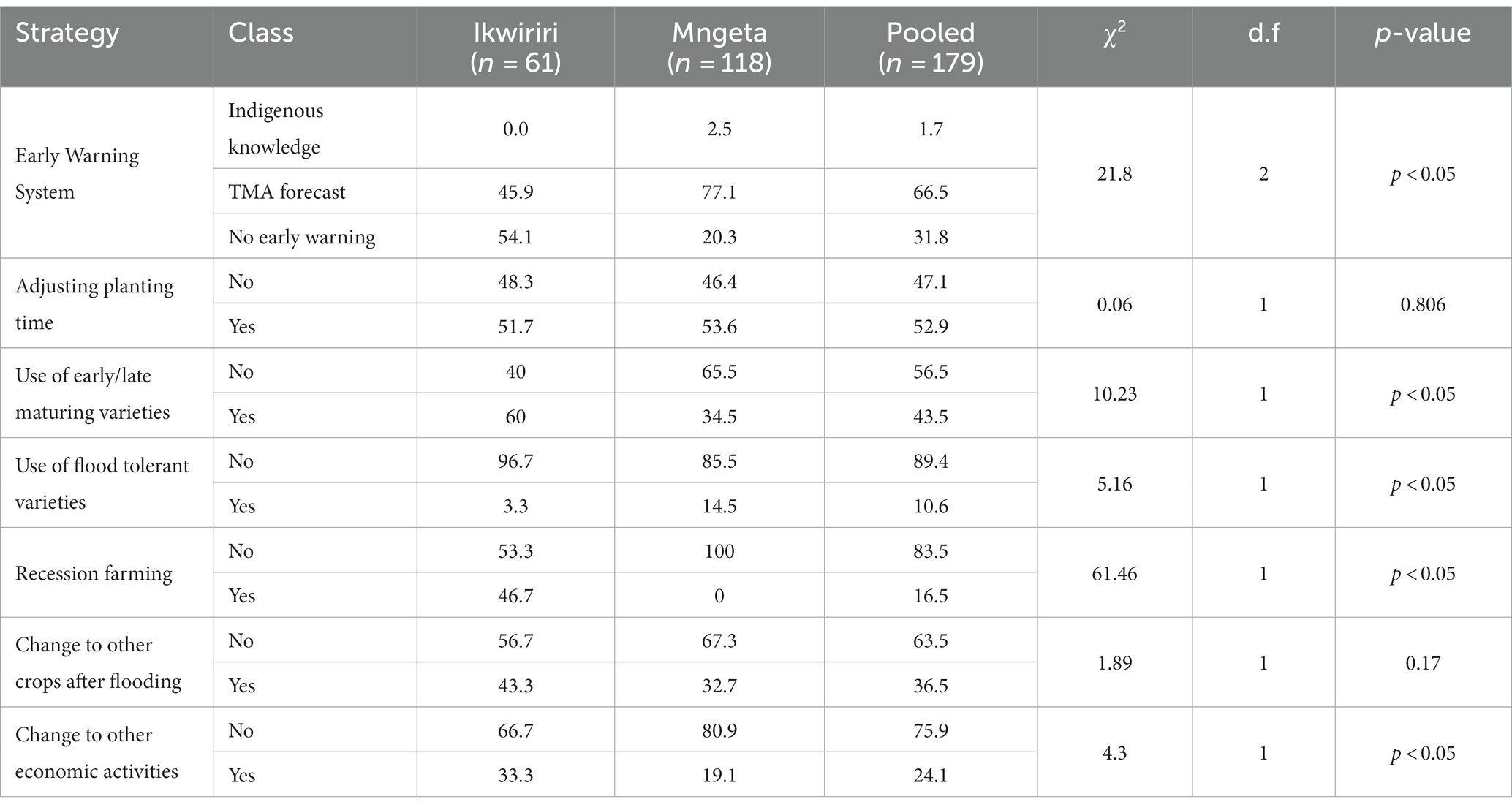
Table 8. Strategies used by lowland rice farmers of Mngeta and Ikwiriri to cope with extreme flood events.
The majority of farmers in Mngeta (77.1%) and barely half of the sample population in Ikwiriri (45.9%) are accessing weather forecast information from the Tanzania Meteorological Agency (TMA). Results found that 52.9% have been using “adjustment of rice planting schedule” as their main copping strategy to extreme floods. Conversely, 60% and 34.5% of the respondent farmers in Mngeta and Ikwiriri reported the use of early and late maturing rice cultivars, respectively (p < 0.05). Early maturing varieties were reported to be planted in areas with less flood frequency but prone to water scarcity. Few farmers, mostly in Mngeta reported to have been growing rice varieties which they perceive to be tolerant to floods.
The aftermath responses to flood events include adoption of recession farming with complete reliance on residue moisture when flood water recedes, changing to other crops, or changing to other economic activities (Table 9). Recession farming, also locally known as “Mlao” is practiced exclusively by nearly half the respondent population in Ikwiriri (46.7%), among the study sites (p < 0.05). In the recession farming practice, flooded rice farms are used for cultivating rice, maize, and vegetables.
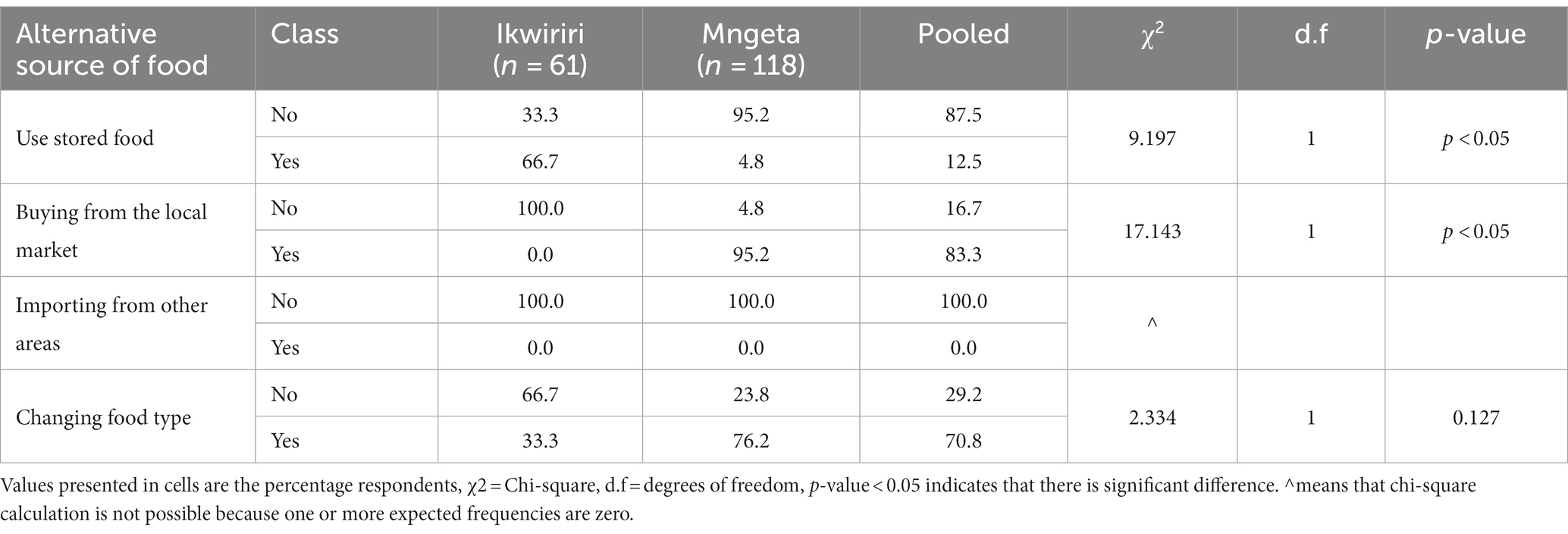
Table 9. Alternative sources of food for rice farmers of two study sites during extreme floods events.
Farmers in the studied population also rely on sales of cash crops such as cocoa, cashew, and banana, that are mainly grown on levees around their houses as a means of copping with financial downturn imparted by flood losses. Some farmers, mostly in Ikwiriri (p < 0.05), acknowledged to have been shifting to other economic activities such as fishing in the periods of extreme floods.
Farmers did also report on their alternative sources of food in case of severe crop failure during extreme floods. Most common alternative source of food is using stored food, with 87.5% of respondents reporting this as their means of sustenance across the sites. In contrast, only 12.5% reported buying food from the local market. Changing food type was also a common alternative, with 70.8% of respondents reporting this. Importing food from other areas was not reported by any of the respondents.
The chi-square test results showed that there was a significant difference between the two study sites for the “Buying from the local market” and “Using stored food” sources of food, with p-values of 0.000 and 0.002, respectively. Most farmers in Mngeta (95%) rely on buying food from the market while the majority of Ikwiriri farmers (66.7%) rely on stored food in periods with flood-inflicted losses. This suggests that the rice farmers in the two study sites have different behaviors when it comes to alternative sources of food during extreme floods.
4 Discussion
In this section, we provide a discussion of our findings on impact of floods on lowland rice production in the Kilombero and Lower-Rufiji floodplains in Tanzania. Specifically, we investigate the experiences of farmers in Mngeta division and Ikwiriri ward, as well as the causes and dynamics of floods, and the strategies farmers use to cope with flooding. By doing so, we hope to provide a comprehensive understanding of the challenges faced by rice farmers in flood-prone regions and the approaches they use to mitigate the impacts of floods in two floodplains.
The study found that agriculture plays a vital role in both sustaining livelihoods and ensuring food security in the study locations, with rice and maize being the primary crops grown for sustenance and income generation. Notably, the majority of farmers (96.1%) in the study regions placed a high importance on rice farming, which is consistent with previous reports from Kilombero Valley (Kato, 2007; Leemhuis et al., 2017; Gabiri et al., 2018) and Lower-Rufiji (Duvail and Hamerlynck, 2007). Other crops such as bananas, cocoa, cashew, and simsim are also grown in small farms on levees around households.
The floodplains of Kilombero and Lower-Rufiji have been attributed to huge potential for rice intensification (Hamerlynck et al., 2010; Gebrekidan et al., 2020). Currently cultivation in floodplains is highly dependent to rainfall which makes production susceptible to hydrodynamic risks particularly floods and drought. This is demonstrated by the findings of this survey whereby all farmers are using lowland rainfed rice production systems over irrigated or upland rainfed systems. This is an important finding since rainfed lowland systems are most vulnerable to climate extreme events (Pathak et al., 2021), for which this survey revealed flood to be a most consistently encountered stress in the two study areas. The vulnerability of rainfed lowland rice production systems to extreme weather events such as floods has been well documented in the literature (Mackill et al., 2010; Duncan et al., 2017). Van Oort and Zwart’s (2018) study projects that the future climate scenarios may positively influence yields of irrigated rice in East Africa, while lowland rice ecosystems are likely to suffer yield losses. Therefore, to enhance rice yields in lowland rice areas, water and nutrient management practices remain to be critical factors that require optimization (Van Oort and Zwart, 2018; Kwesiga et al., 2019).
4.1 Understanding flood occurrences and dynamics
The present study revealed that all farmers in Ikwiriri and Mngeta have experienced flood episodes in their rice farms, either occasionally or almost every year. In farmer’s perceptions, flood occurrence has been associated with various factors including overflowing of the rivers, heavy storms, gentle gradients, and lack of infrastructure for flood control. Previous studies in Kilombero valley also reported farmer’s intrusion to seasonally inundated wetlands (Munishi and Jewitt, 2019; Msofe et al., 2020), which could be the reason for flood occurrences in their fields as there field are shifted into flood hotspots. The factors are beyond farmers control, and therefore shifting to resilient interventions become inevitable. The interventions can range from developing early warning system that aid farmers decisions, planting tolerant rice varieties and improving their production practices.
Farmers may know that floods are likely, but aren’t sure when it is going to happen. Unpredictability of flood events to farmers is thus a challenge especially in face of multiple flood-causal agents identified. This is further aggravated by current non-existence of the established spatial–temporal pattern of flood occurrences in the study areas (Van-Oort, 2018). Accordingly, farmers indicated the correspondence of flood occurrence with the two rain seasons, with floods being more common during long rain season (March to May), and less likely during short rain season (October to December). This observation suggests the need for and effective dissemination of spatial–temporal maps indicating the pattern of flood hotspots as well as high-quality meteorological predictions in guiding farmer’s decision prior flood occurrences.
4.2 Impacts of floods on rice production and famer’s livelihood
This survey showed that the majority of rice farmers are suffering flood-inflicted yield losses, with more than 70% of farmers losing above 50% of rice yields across the sites. The effect of floods on rice yield losses was more pronounced in farms that are closer to river or river tributaries, implying extreme submergence. Previous experimental studies in Kilombero valley attributed rice yield losses to unfavorable hydrology, mainly duration of crop submergence (Gabiri et al., 2018; Kwesiga et al., 2020; Michael et al., 2023). For the farms that are too closer to the river (center positions), the yield gap (the difference between attainable and actual yield) become non-accountable even with additional management practices such as field leveling and nutrient management.
Between the two sites, Ikwiriri farmers are facing higher losses compared to Mngeta. This aligns with their report that floods are highly stressful in their area, regardless of whether or not it rained in their locality. The most agreed reason for the highly stressful floods in Ikwiriri is the overflow of Rufiji River, which receives water from three sub-basins in Rufiji valley (Kilombero, Luwengu, and Ruaha). The flood scenarios pointed out by Duvail and Hamerlynck (2007), shows that high floods are normally not synchronized with rains rather the overflow of Rufiji River and it destroys rice crop.
Farmers did also associate crop losses with crop establishment methods they used and crop growth stage at which flood occurred. Direct seeding is the most flood susceptible rice establishment method, and yet mostly used method even with farmers prior knowledge on its susceptibility. The reason for using direct seeding is because of it being less costly and reduces drudgery as compared to transplanting method, as it is reported also in other parts of the world (Ismail et al., 2012). These findings suggest the need for strengthening direct seeding system through breeding for rice cultivars, and improving seed delivery system for seeds that are tolerant to anaerobic germination.
Observations from farmers also indicate that it is worth noticing when floods are likely to occur and a crop stage susceptibility. Usually, higher loses are observed if floods occur during short rain season when rice is either being sown or is at early seedling stage. Proneness of seeding stage is because floods hinder the rice seed germination process, leading to low seed viability and weak seedling growth (Panda and Barik, 2021), which for the case of farmers in this survey leads to a need for resowing the crop. This emphasizes on anaerobic rice germination as being a critical flood related stress, considering that farmers are using direct seeding method.
With reference to farmers cropping calendar, vegetative growth to harvesting stages are seemingly in alignment with the periods of long rain season, where floods are reportedly common. Herein, rice crops succumb to vegetative submergence where yield losses are reported. Vegetative submergence can cause reduced plant growth and yield, and flash floods can uproot crops and cause severe damage (Das et al., 2009). Floods can also cause the lodging of rice plant panicles into floodwaters, leading to grain quality loss and decreased market value of rice produced (Zhou et al., 2020).
Moreover, the impacts of floods on farmers in the two study areas are not limited to crop losses. Farmers are also experiencing difficulties in establishing and managing crops during floods. For instance, the distinctive poor adoption of nitrogen-based fertilizers has been associated also with uncertainty of the hydrology of the floodplains, particularly floods occurrence (Kwesiga et al., 2020). Consequently, abandonment of the fields becomes an option where crop establishment and management become difficult. Higher rate of crop land abandonment has been observed in Ikwiriri compared to Mngeta, where floods were observed to be more stressful. In this respect, floods occurring in the areas under study strip farmers of their primary sources of food and income, necessitating that they seek out alternative options. The results suggest a link between agricultural disruption due to flooding and food insecurity and poverty in the two study areas.
4.3 Existence of floods and multiple biotic and abiotic stresses
The farmer’s insights on the co-occurrence of two contrariwise hydrological stress, floods, and droughts, revealed that short-lived flash floods can be followed by a prolonged drought even within a single crop season. Surprisingly, Ikwiriri site, which experiences highly stressful floods is the one that faces more extended periods of drought. The effects of multiple stressors are not only implied directly at instancy of their occurrence but also limiting farmer’s choices for improving rice production practices and other economic activities. The choice of using improved short maturing high yielding rice varieties is then highly affected by flood and drought. For example, the choice of the improved high yielding variety SARO 5 (TXD 306) is limited due to its shortness as it can be vulnerable to submergence and other hand cannot withstand prolonged drought. The existence of rice diseases particularly rice yellow mottle virus (RYMV) locally known as “Kimiyanga” even complicates farmers adaptation to stresses in two study areas. The prevalence of RYMV has also been previously reported by Suvi et al. (2021). This calls for multi-trait breeding programs in rice growing areas encountering multiple stresses within a growing season, since sole occurrences of stresses is uncommon.
As of this survey, soil salinity was not reported as a problem by most of lowland rice farmers of Mngeta and Ikwiriri, as opposed to the reports from many irrigated rice schemes of Tanzania (Kashenge-Killenga et al., 2014; Omar et al., 2022). The underlying reason for absence of salt-affected soil could be periodic flushing and leaching of salts by flood water along with farmers non-utilization of field bunds.
4.4 Farmer’s practices and opportunities for copping with floods and multiple stressors
Farmer’s understanding of flood-proneness of their rice growing ecosystems has driven their attitude toward the use diverse yet unspecific coping strategies. These strategies include adjusting the planting schedule, using early or late maturing rice varieties, using flood-tolerant rice varieties, and adopting recession farming.
The majority of farmers in Mngeta have access to weather forecast information from the Tanzania Meteorological Agency. However, the use of forecast information in guiding resilience intervention is minimal mainly due to inadequacy of knowledge on how to use this information. These findings suggest the importance building farmer’s knowledge of using reliable weather forecast information to make informed decisions about their crop management schedule so as to reduce the impacts of floods on their crops.
This survey evinces that the use of improved flood-tolerant rice cultivars in the study locations is currently lacking, with almost 97% of the reported varieties being local landraces. Farmers do cultivate mix of local rice landraces, some of which they perceive to be flood-tolerant, to reduce chances for yield losses and benefit other traits such as grain quality and aroma. Most of the traits associated with tolerance of different types of flooding stress are expressed better in traditional landraces being grown by farmers (Ismail et al., 2012). As of moment, most of improved cultivars available in Tanzania have been bred for improving yields under irrigated systems and non for flood tolerance in rainfed lowland ecosystem. This underscores the need for detailed screening for presence of tolerance genes against flood-related stresses such as anaerobic germination (AG1 and AG2) and vegetative submergence (SUB1 gene).
In face of vegetative rice submergence stress, tall landrace varieties are cultivated by farmers in flood-prone areas. Most of the tall varieties are late maturing varieties and due to occurrence of contrariwise hydrological stress “prolonged drought and floods” their potential is compromised. Again, farmers claim of these varieties to be susceptible to pest and diseases, particularly Rice Yellow Mottle Virus (RYMR). Therefore, the study highlights the importance of breeding for and promoting flood-tolerant rice varieties as well as introgression of multiple stress tolerance to help farmers mitigate the impacts of floods and its coexistence with other stresses. The use of varieties tolerant to flood related stresses has been observed in many Asian countries and its adoption has helped millions of farmers in Southeast Asia where floods are common (Raghu et al., 2022). Efforts on breeding for multiple-stress tolerance, such as submergence tolerance plus drought tolerance have been made documented by Mackill et al. (2012), in rainfed lowland areas of Asia with multiple stresses.
Additionally, recession farming is used as strategy for farmers to cope with flood events, especially in Ikwiriri. By cultivating rice and other crops using residual moisture after flood recession, farmers increase their chances of stabilizing their food security. However, this option becomes a challenge in years with no floods and when soil moisture is not enough to suffice crop water requirement.
Farmers of the two study areas do also utilize off-farm strategies to survive the impacts of extreme floods by shifting to other economic activities such as fishing and switching to different food sources. This strategy highlights the importance of diversifying food and income sources for farmers in flood-prone areas. However, the occurrence of droughts reduces their chances of maintaining their livelihood. The problem become more pronounced in Ikwiriri since fishing is a most plausible economic activity during floods and yet their area experiences extended periods of drought.
4.5 Relevance of the study to other areas
This study, centered on Kilombero and Lower-Rufiji floodplains, holds broad relevance. The insights can guide strategies for coping with flood-related stresses in similar regions worldwide, shaping policy-making and climate change adaptation efforts. As rice is a staple food for a large portion of the world’s population, enhancing its production’s resilience to floods is critical for food security. This study contributes valuable knowledge towards this goal. Furthermore, understanding the impacts of floods on farmers’ livelihoods can help develop mechanisms to safeguard their income, contributing to socio-economic development in these regions. Therefore, while geographically specific, the implications of this study are wide-ranging and vital for enhancing resilience to floods, informing policy and practice, supporting climate change adaptation efforts, ensuring food security, and promoting socio-economic development.
5 Conclusion
The findings of this study provide a better understanding of the flood dynamics and impacts on rice production and the livelihood of farmers in the Kilombero and Lower-Rufiji floodplains of Tanzania. The study has identified strategies used by farmers to cope with floods, including the use of early and late maturing rice varieties, adopting recession farming, and diversifying food and income sources, these strategies are observed not to ensure resilience toward flooding stress. The findings suggest that interventions such as developing early warning systems, breeding for flood-tolerant rice varieties, and improving crop establishment methods and nutrient management practices could help enhance resilience of farmers to floods and other extreme weather events. The study underlines the need for detailed screening for presence of tolerance genes against flood-related stresses and the need for breeding for multiple-stress tolerance to help farmers mitigate the impacts of floods and other stresses.
Data availability statement
The raw data supporting the conclusions of this article will be made available by the authors, without undue reservation.
Ethics statement
The studies involving humans were approved by the study adhered to the ethical research guidelines of Sokoine University of Agriculture and the Tanzanian government, and it received approval from both entities. The Morogoro Regional Commissioner’s Office and Coastal Regional Commissioner’s Office granted written permission to conduct research in the study areas, with reference numbers AB.175/245/01′′I′/42 and F.A.221/265/01F/56, respectively. Prior to conducting interviews, the researchers explained the purpose of the study and obtained informed consent from all participants. The respondents were assured of confidentiality and anonymity, and their participation was voluntary, with the option to withdraw from the interview at any time. The studies were conducted in accordance with the local legislation and institutional requirements. The participants provided their written informed consent to participate in this study.
Author contributions
PM conceptualized the study, collected the data, conducted the analysis and drafted the manuscript. DK, PM, and LM conducted the analysis and, DK, HS, MS, MH, JM and BM reviewed and edited the study concept and the draft manuscript. All authors contributed to the article and approved the submitted version.
Funding
This study was funded by DANIDA as part of the “Climate Smart African Rice Research Project” with grant agreement no. 18-03-KU.
Acknowledgments
We are grateful to the farming communities and extension officers of Mngeta and Ikwiriri wards for their time, hospitality, and help in completing this study. We also extend our special thanks to Morogoro and Pwani Regional Administration Office and Local Government Authorities in research areas for granting permission to conduct this study.
Conflict of interest
The authors declare that the research was conducted in the absence of any commercial or financial relationships that could be construed as a potential conflict of interest.
Publisher’s note
All claims expressed in this article are solely those of the authors and do not necessarily represent those of their affiliated organizations, or those of the publisher, the editors and the reviewers. Any product that may be evaluated in this article, or claim that may be made by its manufacturer, is not guaranteed or endorsed by the publisher.
References
Bailey-Serres, J., Fukao, T., Ronald, P., Ismail, A., Heuer, S., and Mackill, D. (2010). Submergence tolerant rice: SUB1’s journey from landrace to modern cultivar. Rice 3, 138–147. doi: 10.1007/s12284-010-9048-5
Das, K. K., Panda, D., Sarkar, R. K., Reddy, J. N., and Ismail, A. M. (2009). Submergence tolerance in relation to variable floodwater conditions in rice. Environ. Exp. Bot. 66, 425–434. doi: 10.1016/j.envexpbot.2009.02.015
Duncan, J. M., Tompkins, E. L., Dash, J., and Tripathy, B. (2017). Resilience to hazards: rice farmers in the Mahanadi Delta, India. Ecol. Soc. 22, 1–14. doi: 10.5751/ES-09559-220403
Duvail, S., and Hamerlynck, O. (2007). The Rufiji River flood: plague or blessing? Int. J. Biometeorol. 52, 33–42. doi: 10.1007/s00484-007-0105-8
Gabiri, G., Burghof, S., Diekkrüger, B., Leemhuis, C., Steinbach, S., and Näschen, K. (2018). Modeling spatial soilwater dynamics in a tropical floodplain, East Africa. Water (Switzerland) 10, 1–27. doi: 10.3390/w10020191
Gebrekidan, B. H., Heckelei, T., and Rasch, S. (2020). Characterizing farmers and farming system in Kilombero Valley floodplain, Tanzania. Sustainability (Switzerland) 12, 1–21. doi: 10.3390/su12177114
Georgiev, G. Z. (2020). Random number generator, [Available at: https://www.gigacalculator.com/ calculators/random-number-generator.Php URL] site visited on 17/01/2021.
Hamerlynck, O., Duvail, S., Hoag, H., Yanda, P., and Paul, J.-L. (2010). “The large-scale irrigation potential of the lower Rufiji floodplain: reality or persistent myth?” in Shared waters, shared opportunities: Hydropolitics in East Africa. eds. B. Calas and C. A. M. Martinon, 1–282.
Harlan, Jack R., and Ann, Stemler. (1976). “The Races of Sorghum in Africa,” in Origins of African Plant Domestication. De Gruyter Mouton. 465–478.
Höllermann, B., Näschen, K., Tibanyendela, N., Kwesiga, J., and Evers, M. (2021). Dynamics of human–water interactions in the Kilombero Valley, Tanzania: insights from farmers’ aspirations and decisions in an uncertain environment. Eur. J. Dev. Res. 33, 980–999. doi: 10.1057/s41287-021-00390-4
Ikart, E. M. (2019). Survey questionnaire survey pretesting method: an evaluation of survey questionnaire via expert reviews technique. Asian J. Soc. Sci. Stud. 4:1. doi: 10.20849/ajsss.v4i2.565
Ismail, A. M., Johnson, D. E., Ella, E. S., Vergara, G. V., and Baltazar, A. M. (2012). Adaptation to flooding during emergence and seedling growth in rice and weeds, and implications for crop establishment. AoB Plants 2012, 1–18. doi: 10.1093/aobpla/pls019
Kashenge-Killenga, S., Tongoona, P., Derera, J., and Kanyeka, Z. (2014). Farmers’ perception of salt affected soils and rice varieties preferences in the North-Eastern Tanzania and their implications in breeding. Int. J. Dev. Sustain. 33, 2168–8662.
Kato, F. (2007). Development of a major rice cultivation area in the Kilombero Valley, Tanzania. Afr. Study Monogr. 36, 3–18. doi: 10.14989/68498
Kuroha, T., and Ashikari, M. (2020). Molecular mechanisms and future improvement of submergence tolerance in rice. Mol Breeding 40:41. doi: 10.1007/s11032-020-01122-y
Kwesiga, J., Grotelüschen, K., Neuho, D., Senthilkumar, K., Döring, T. F., and Becker, M. (2019). Site and management E ff ects on grain yield and yield variability of Rainfed lowland Rice in the Kilombero floodplain of Tanzania. Agronomy, 1–16. doi: 10.3390/agronomy9100632
Kwesiga, J., Grotelüschen, K., Senthilkumar, K., Neuhoff, D., Döring, T. F., and Becker, M. (2020). Rice yield gaps in smallholder systems of the kilombero floodplain in Tanzania. Agronomy 10, 1–14. doi: 10.3390/agronomy10081135
Leemhuis, C., Thonfeld, F., Näschen, K., Steinbach, S., Muro, J., Strauch, A., et al. (2017). Sustainability in the food-water-ecosystem nexus: the role of land use and land cover change for water resources and ecosystems in the Kilombero wetland, Tanzania. Sustainability (Switzerland) 9, 2–18. doi: 10.3390/su9091513
Mackill, D. J., Ismail, A. M., and Pamplona, A. (2010). Stress tolerant Rice varieties for adaptation to a changing climate stress tolerant Rice varieties for adaptation to a changing climate. Crop. Environ. Bioinform. 7, 250–259.
Mackill, D. J., Ismail, A. M., Singh, U. S., Labios, R. V., and Paris, T. R. (2012). Development and rapid adoption rice varieties. I Advances Agron. 1, 299–352. doi: 10.1016/B978-0-12-394276-0.00006-8
Michael, P. S., Sanga, H. G., Shitindi, M. J., Herzog, M., Meliyo, J. L., and Massawe, B. H. J. (2023). Uncovering spatiotemporal pattern of floods with Sentinel-1 synthetic aperture radar in major ricegrowing river basins of Tanzania. Front. Earth Sci. 11:1183834. doi: 10.3389/feart.2023.1183834
Msofe, N. K., Sheng, L., Li, Z., and Lyimo, J. (2020). Impact of land use / cover change on ecosystem service values in the Kilombero Valley floodplain, southeastern Tanzania. Forest 11, 1–17. doi: 10.3390/f11010109
Munishi, S., and Jewitt, G. (2019). Degradation of Kilombero Valley Ramsar site. Phys. Chem. Earth 112, 216–227. doi: 10.1016/j.pce.2019.03.008
Nanda, T., Gupta, H., Kharub, M., and Singh, N. (2013). Diagnostics for pretesting questionnaires: A comparative analysis. Int. J. Technol. Policy Manag. 13, 67–79. doi: 10.1504/IJTPM.2013.051008
Omar, M. M., Shitindi, M. J., Massawe, B. H. J., Fue, K. G., and Pedersen, O. (2022). Exploring farmers’ perception, knowledge, and management techniques of salt-affected soils to enhance rice production on small land holdings in Tanzania. Food Agric. 8, 1–20. doi: 10.1080/23311932.2022.2140470
Panda, D., and Barik, J. (2021). Flooding tolerance in Rice: focus on mechanisms and approaches. Rice Sci. 28, 43–57. doi: 10.1016/j.rsci.2020.11.006
Pathak, H., Kumar, M., Molla, K. A., and Chakraborty, K. (2021). Abiotic stresses in rice production: impacts and management. Oryza Int. J. Rice 58, 103–125. doi: 10.35709/ory.2021.58.spl.4
Raghu, P. T., Veettil, P. C., and Das, S. (2022). Smallholder adaptation to flood risks: adoption and impact of Swarna-Sub1 in eastern India. Environ. Chall. 7:100480. doi: 10.1016/j.envc.2022.100480
Rodenburg, J., Zwart, S. J., Kiepe, P., Narteh, L. T., Dogbe, W., and Wopereis, M. C. S. (2014). Sustainable rice production in African inland valleys: seizing regional potentials through local approaches. Agric. Syst. 123, 1–11. doi: 10.1016/j.agsy.2013.09.004
Shin, N.-H., Han, J.-H., Jang, S., Song, K., Koh, H.-J., Lee, J.-H., et al. (2020). Early vigor of a pyramiding line containing two quantitative trait loci, phosphorus uptake 1 (Pup1) and anaerobic germination 1 (AG1) in Rice (O. sativa L.). Agriculture 10:453. doi: 10.3390/agriculture10100453
Singh, S., Mackill, D. J., and Ismail, A. M. (2011). Tolerance of longer-term partial stagnant flooding is independent of the SUB1 locus in rice. Field Crop Res. 121, 311–323. doi: 10.1016/j.fcr.2010.12.021
Suvi, W. T., Shimelis, H., Laing, M., Mathew, I., and Shayanowako, A. I. T. (2021). Variation among Tanzania Rice germplasm collections based on agronomic traits and resistance to Rice yellow mottle virus. Agronomy 11:391. doi: 10.3390/agronomy11020391
Van Oort, P. A. J., and Zwart, S. J. (2018). Impacts of climate change on rice production in Africa and causes of simulated yield changes. Glob. Chang. Biol. 24, 1029–1045. doi: 10.1111/gcb.13967
Van-Oort, P. A. J. (2018). Mapping abiotic stresses for rice in Africa: drought, cold, iron toxicity, salinity and sodicity. Field Crop Res. 219, 55–75. doi: 10.1016/j.fcr.2018.01.016
Keywords: extreme climate events, floodplains, lowland rice, adaptation, abiotic stresses
Citation: Michael PS, Mwakyusa L, Sanga HG, Shitindi MJ, Kwaslema DR, Herzog M, Meliyo JL and Massawe BHJ (2023) Floods stress in lowland rice production: experiences of rice farmers in Kilombero and Lower-Rufiji floodplains, Tanzania. Front. Sustain. Food Syst. 7:1206754. doi: 10.3389/fsufs.2023.1206754
Edited by:
Jan Van Der Ploeg, Van Hall Larenstein University of Applied Sciences, NetherlandsReviewed by:
Eric Brako Dompreh, WorldFish (Malaysia), MalaysiaDiego Portalanza, Agrarian University of Ecuador, Ecuador
Copyright © 2023 Michael, Mwakyusa, Sanga, Shitindi, Kwaslema, Herzog, Meliyo and Massawe. This is an open-access article distributed under the terms of the Creative Commons Attribution License (CC BY). The use, distribution or reproduction in other forums is permitted, provided the original author(s) and the copyright owner(s) are credited and that the original publication in this journal is cited, in accordance with accepted academic practice. No use, distribution or reproduction is permitted which does not comply with these terms.
*Correspondence: Paulo Sulle Michael, pauloprotus@gmail.com
 Paulo Sulle Michael
Paulo Sulle Michael Lupakisyo Mwakyusa
Lupakisyo Mwakyusa Hilda G. Sanga1
Hilda G. Sanga1 